#the problem with my pc is its GOOD but due to a series of unfortunate steps that led me to this point.... in order to replace 1 part
Explore tagged Tumblr posts
Text
so if i start this j*b in july do we think i have the time but more importantly the courage and discipline to save for a 3k pc overhaul before datv drops. serious answers only
#i feel like my pc CAN run it as it is. but i want to be able to see each individual rain droplet on my rook's face lol#otherwise maybe i'll just buy a ps5. but hhhh#the problem with my pc is its GOOD but due to a series of unfortunate steps that led me to this point.... in order to replace 1 part#i'll need to replace 7#which. isnt ideal#honestly im so thrown off balance by the fall 2024 release . genuinely thot it wasnt coming out at all let alone within the year for a min
7 notes
·
View notes
Text
Never7 -the end of infinity- review
Kotaro Uchikoshi holds the title of being one of the most magnificently insane writers in Japan, which is saying something. He’s most famous for the Zero Escape trilogy, an innovative mix of escape-the-room puzzles and normal visual novel story sequences, and the much more recent AI: The Somnium Files, a more standard, yet equally memorable detective drama, which I actually wrote a full review on right here. Though, all things considered, “famous” would be a bit of an overstatement, as these games are very much cult games, being all but completely ignored in Japan, and not doing fantastic overseas either, with the upside of those who have played them often loving them, including me, with Nine Hours, Nine Persons, Nine Doors and AI: The Somnium Files being some of my favorite games out there. However, before the days of Zero Escape, Uchikoshi got his start working at KID, a now defunct developer most famous for its two visual novel series, those being Memories Off, a series of romance VNs that have unfortunately never seen the light of day outside of Japan, not even through fan translations, and the Infinity series, the brainchild of Uchikoshi and the equally insane Takumi Nakazawa, consisting of Never7, Ever17, Remember11, 12Riven, and Code_18, though, reasonably speaking, only those first three, as the latter two were pretty badly received. Science fiction VNs that are mostly connected by their shared themes, these games laid the groundwork for Zero Escape, and are ironically the exact opposite in terms of popularity, being well received and popular in Japan when released, but almost completely unknown in America even today, for understandable reasons, as only Ever17 was officially released in English, with Never7 and Remember11 only being playable with fan translations, along with just being old. Never7 originally was released in 2000, with Ever17 and Remember11 coming out in 2002 and 2004 respectively. Needless to say, these games have long lost their chance at the spotlight, but my curiosity has driven me to them, and thus, we arrive at today’s topic: the first game in the series, Never7. Note that I played the PSP version, as while the translation was originally made for the PC version, that version is really not recommended, for reasons I’ll detail later in the review. Either way, here it be.
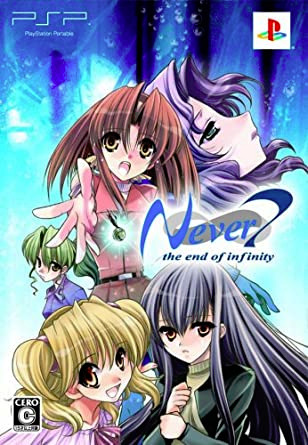
20 year old Makoto Ishihara is an unremarkable college student theoretically majoring in psychology, but in practice has majored in skipping the majority of his classes due to his lack of personal direction. This slacker attitude comes back to bite Makoto when he finds himself forcibly signed up for the strange “Seminar Camp”, set on a faraway island and lasting from April 1st to April 7th, with no apparent purpose other than to strengthen the bonds between the members of the group. The other members of Makoto’s group are Yuka Kawashima, a friendly, outgoing girl who serves as the group’s leader, Haruka Higuchi, a quiet, mysterious honor student, and Okuhiko Iida, an infamous playboy who also happens to be heir to the Iida Financial Group. During their week on the island, the group also befriends three others unrelated to the camp: Saki Asakura, an old friend of Yuka’s who comes from a rich family, Kurumi Morino, an energetic and cheerful girl, and her older sister Izumi Morino, the temporary manager of the cafe Lunabeach, whose motherly nature quickly gives her a place as the mediator of the group.
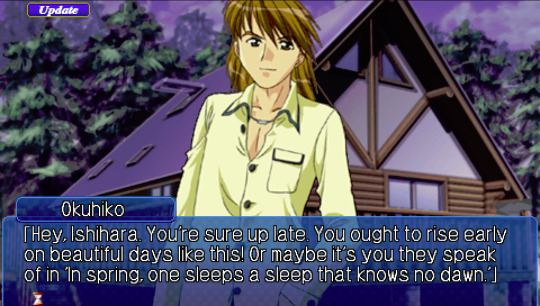
Unfortunately, this otherwise relaxing stay proves to have its own share of problems, mostly within the group. Yuka, despite being the leader, is rather reckless, with a tendency to get unreasonably drunk every chance she gets. Haruka avoids interaction to the point of seeming cold, and insists, among other things, that she “has no heart”. Okuhiko is a shallow jerk who instantly takes a disliking to Makoto, and has a fixation on Haruka that he takes to controlling levels, despite her clear disinterest. Saki, though perfectly affable in group settings, is unnecessarily difficult, stubborn, and harsh in one on one conversation, with a tendency to lash out at others when upset. Kurumi is extremely childish, despite being 17 years old, and even the otherwise dependable Izumi is more than a bit scatterbrained and secretive. As both bonds and tensions form within the group over the week, Makoto is faced with something far more concerning: mysterious premonitions of near future events that always turn out to be correct, coupled with a strange dream which seems to predict the death of someone on the 6th while holding a strange bell, with him soon finding said bell washed up on the beach one night.

It’s pretty much impossible to talk about this game without giving away that it is much more than a simple romance VN, despite it being the big twist of the game when it was first released. Unfortunately, the twists of the game mostly rely on being a surprise, and aren’t very developed otherwise, for the most part, and the story is mostly focused on romance. Considering how elaborate Uchikoshi’s later games are, this is absolutely the biggest reason why Never7 remains so obscure even by Infinity’s standards, considering that Uchikoshi fans are pretty much the only ones who’d be interested in this game nowadays, and knowing that this game isn’t even close to the same level of complexity as his more famous games is the biggest thing that has to be kept in mind when considering anything about it.
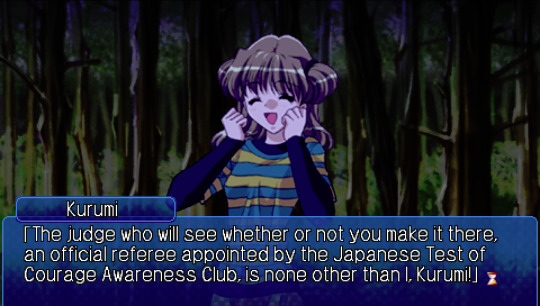
The game consists of a beginning common route, 5 routes for Yuka, Haruka, Saki, Kurumi, and Izumi, and the two Curé routes: Izumi Curé, the final route, which takes the plot in a vastly different direction, and serves to completely supplant Izumi’s original route as well, as it’s rather infamously disappointing, and Yuka Curé, a retelling of Yuka’s route from her own perspective. While Yuka Curé is an extra accessed outside of the main game, the rest are accessed in pretty typical VN fashion: the game starts with a common route that serves to introduce the characters, setting, and a few plot elements, before eventually diverging into one of several character specific routes depending on your choices within the common route, namely building up affection points with the characters, and seeing specific, important scenes concerning them. Having enough points and having all requisite plot flags will lock you into that character’s route, with the game otherwise defaulting to Yuka’s route. Not anything atypical of the genre here.
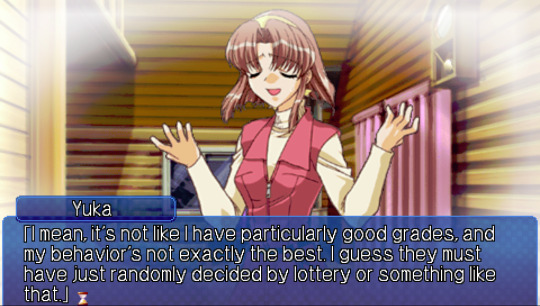
For the most part, this system is fairly forgiving, and works fine. It’s usually pretty easy to figure out what choices actually affect affection, whether from the options themselves, or the reactions of the characters, and the amount of points needed is fairly lenient for each. There’s also a scene near the end common route that has several variations based on which character you have the most affection with, once again defaulting to Yuka if you don’t have sufficient points with any of the others, allowing you an easy way to figure out if you’re on the right path. That said, there’s still definitely frustrations it can cause. While you technically have plenty of freedom to choose what route to pursue on your first playthrough, only Yuka and Haruka’s routes are on the easier side, with Saki’s route being difficult to navigate to and through due to her contrarian nature, with most of the options that involve angering her being the ones to raise affection, and Kurumi’s route forcing you to branch off to a scene involving Izumi instead of her when given the option. Izumi’s routes are also very glaringly not available at first, with options related to her in the common route slowly being unlocked with each route completed instead. While it is actually pretty neat to witness and does make sense, as Izumi’s normal route is not at all serious, and the Curé route is absolutely meant to be saved for last, as far as the serious routes go, it’s still kinda awkward once you notice it, and accessing them carries its own frustration, namely pulling the reverse of the Kurumi route situation and needing to go with Kurumi instead of Izumi at the same point.
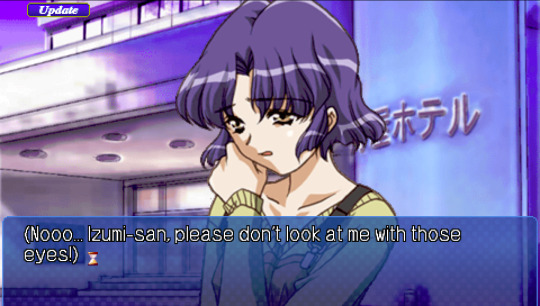
Each route also contains multiple endings, with Yuka’s, Haruka’s, Saki’s, and Kurumi’s routes having one bad and one good ending, Izumi’s routes having two bad endings and one good ending each, and Yuka Curé having one bad and two good endings, all of which depend on certain important decisions within the routes, typically at the climax, with specific steps needing to be taken to achieve the good endings, with everything else leading to the bad endings. It’s actually pretty easy to figure out what’s needed for the good endings most of the time, and even if you screw up, it doesn’t take long to fix your mistake, as the game autosaves at the start of every scene and everytime a decision is available. That said, even this has a few frustrating parts. Kurumi’s ending is a lot easier to screw up than the others, and the Haruka, Saki, and Izumi Curé routes keep the affection mechanic, whereas the others forego it once locked into, forcing you to continue gaining points to reach a certain minimum by the climax, or you’re automatically locked into the bad endings. While it’s still pretty easy to do with Haruka and Izumi, to the point you may gain enough points just from the common route, Saki’s route once again causes the most issue with this mechanic, with the choices tending to be just as confusing as in the common route, which is especially bad if you only barely scraped into her route in the first place. As one last note on the affection mechanic, Yuka and Saki’s routes have scenes and CGs that can only be viewed with certain amounts of affection, with Yuka’s needing a rather high amount that forces you to get as many as possible, and Saki’s rather confusing needing less than a certain high amount, based on my testing. The game barely gives any indication of this, outside of showing scenes in their routes missing in the playing log.
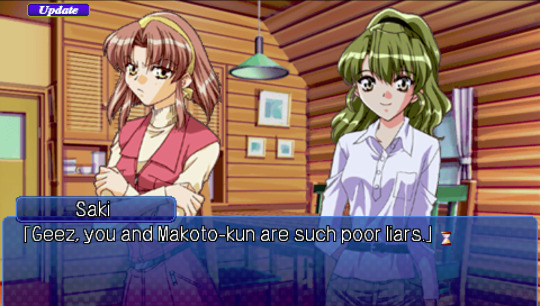
As far as length goes, this isn’t exactly Clannad or Grisaia; while not short, it’s only about average length for a VN. Both the common route and the character routes go by pretty quickly, with only Izumi Curé being noticeably lengthy. The bigger plot elements don’t have much focus at all before the character routes kick in, and only the Izumi Curé and Yuka routes place any great focus on them, which can leave it feeling pretty half baked overall. Additionally, the two Curé routes weren’t even in the original version of the game, which released for the PS1 as Infinity, and thus the elements within Izumi Curé can feel a bit jarring compared to the rest of the game. Altogether, this gives the impression of a game that’s, at best, just average, and only notable as a prototype for the later games in the series. However, while I’m not going to argue against how unappealing Never7′s basic nature can be in comparison to Ever17 or Zero Escape, I actually ended up liking it quite a bit, probably a good deal more than average, and feel it does overall do more things right than wrong.

The cast of characters is by far the best part of Never7. While Makoto is a very basic and forgettable protagonist, and Okuhiko only really exists to be the butt of jokes, though even he gets a couple of moments of depth, everyone else is likeable and complex in their own ways. Yuka, though having a lot of traits that could just easily make her irritating, instead manages to be surprisingly charming. Saki is genuinely sympathetic despite the many low points she has, and the parts of the story that focus on her are generally some of the best parts of the game. My favorite character by far is Haruka, who has, in my opinion, the best route in the game, with many memorable and tender moments as early as the common route, and very well done character development which makes it flow better than a good deal of the other routes, and has a tragic element that stands out even when most of the rest of the cast does as well, which leads to many of the more emotional moments of the game. Haruka’s scenes are another consistent highlight of the writing, and she is overall a surprisingly memorable character among the cast, in my opinion.

Speaking of routes, they’re definitely the other main highlight of the writing. While the structure of the plot means that they can feel a bit samey at times, they do do a good job of developing their respective characters, and do have their own little twists along the way to make them stand out. Additionally, unlike some romance VNs, the rest doesn’t simply vanish outside of their own routes. As the relationships between the cast are important parts of their characters, each character plays a role of some importance in at least one route each, which helps keep focus on each character. It’s not quite perfectly balanced, though; Saki is very noticeably screwed for screentime, only playing a noticeable role in Yuka’s route, and having no presence in any other route besides her own. This also rather bizarrely applies to Yuka herself to a lesser degree, despite being the most blatantly advertised of the characters, while Haruka and Izumi tend to have more of the focus between routes.
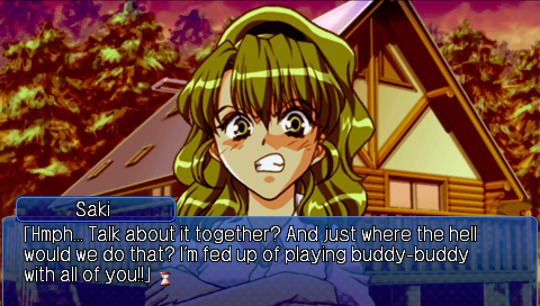
Aside from the aforementioned Haruka route, some of my other favorite routes would be Saki’s route, for its surprisingly tense atmosphere and focus on the tensions within the group giving it a very different feel from most of the other routes, Yuka Curé, as Yuka’s perspective is refreshingly different from Makoto’s and gives her quite a bit more depth, while having a fair few potential divergences from the normal Yuka route, along with giving Saki a very prominent supporting role, and Izumi Curé, for giving the biggest taste of the kind of direction future games would go. The plot elements revealed within are quite interesting, and force you to take a whole different perspective when considering the rest of the game up to this point, and ends with a tasteful amount of ambiguity that, among other things, reasonably lets you decide just which of the routes you think is “real”, despite the seemingly decisive focus and finality it has. Overall, I actually ended up quite a bit more attached to this cast than I was expecting, and while it wasn’t even close to getting to me like, say, Steins;Gate or AI: The Somnium Files, there’s a few decently emotional moments throughout, particularly on the Yuka, Haruka, and Izumi Curé routes.
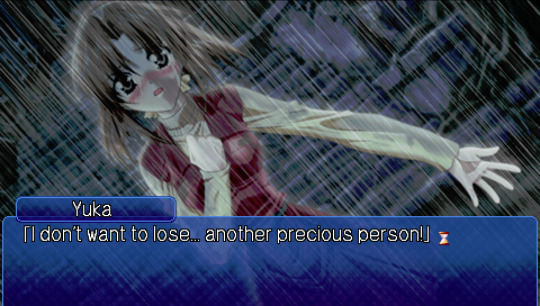

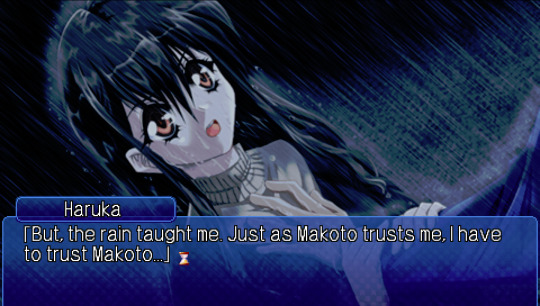
But despite the dark or depressing moments Never7 can get into, in the end, it’s a lighthearted and optimistic game, and all things considered, that’s for the best for it. It’s not trying to be a dark dramatic story, just a relaxing and pleasant experience with a few twists to it, and after going through gruesome experiences like Zero Escape and Chaos;Child, I honestly kinda appreciate that.

As far as the game’s more technical aspects go, the characters and art were done by Yuna Kagesaki, best known for the manga Chibi Vampire/Karin. While the artstyle isn’t anything special, visually, the game is actually quite good looking overall. The character designs all look quite good, and the sprites and CGs are also well made, with the sprites notably giving all the characters many different poses, which make them quite distinct, even if a few tend to make the characters in question look a bit odd. While the PSP’s lower resolution and smaller screen means the sprites and backgrounds don’t look as good as the PC version, and that entire CGs and sprites can’t fit on the screen, it actually looks better than the PC version in places, from visual effects like rain, to the filters placed over the character sprites during sunset and night, to even just the UI. The PC version is extremely bare bones, but the PSP version has plenty of neat little menus and features such as a backlog, a detailed CG gallery that includes promotional artwork along with the art within the game itself, a playing log that includes detailed statistics and allows you to view how many scenes you’ve seen within the game, and how much dialogue you’ve seen within each, a music gallery, and a glossary that helps define terms and concepts within the game. While these aren’t quite special, they are very appreciated all the same, and make the PSP version of Never7 the definitive version. Still, here’s a comparison of the two versions, with the rainbow textbox being exclusive to the PC version.

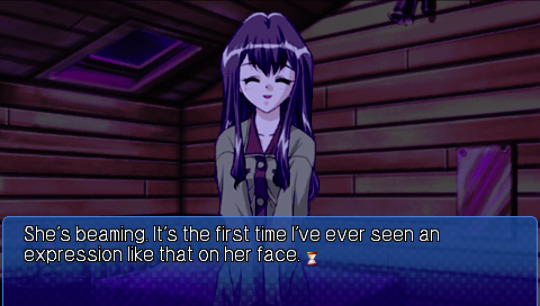
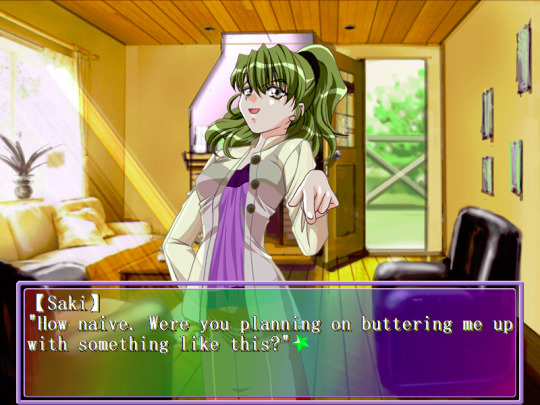
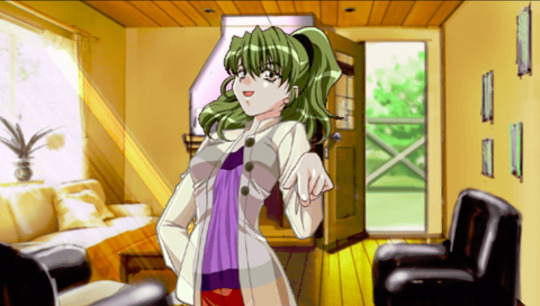
Never7 also features a soundtrack composed by the great Takeshi Abo, who, along with the rest of the Infinity series, is the composer for the Science Adventure series, i.e. Steins;Gate and Chaos;Child. The original soundtrack, used in the PC version, was, to be honest, a bit rough in places, but the PSP version uses a remixed soundtrack first made for the PS2 port, which is nothing short of fantastic. The soundtrack fits the mood of the game perfectly, being very relaxing or upbeat. Each character’s theme fits them perfectly, and the music always manages to fit the context of each scene, particularly the song Languor, which fits both definitions of the word: pleasantly tired, or oppressively stiff. My favorite tracks have to be Izumi’s warm theme, the rather emotional main theme of the game, Once More, and especially Haruka’s downright beautiful theme. Exclusive to the PSP is a rather neat OP played at the start of the game, and an ED used for the original five routes, performed by the band Asriel, with the Curé routes having different EDs that were composed well before this port. Never7 also features a voice cast of voice actors both new and popular at the time, mostly notably the late Tomoko Kawakami as Yuka, Yuki Matsuoka as both Haruka and Kurumi, and Kikuko Inoue as Izumi. Everyone does a pretty decent job, with Yuki Matsuoka particularly managing to make both her characters sound very different. Most of the voice acting is rather compressed, even if it still sounds okay, but the voice acting in the Izumi Curé route is uncompressed, which, while a bit jarring when compared to the original voice acting, certainly sounds much better.

Overall, whether or not I would recommend Never7 heavily depends. If you want a crazier, much more visibly Uchikoshi experience, a much deeper kind of romance game like Clannad, or even just an especially emotional experience, you’re not likely to be impressed, and it’s not recommended in that case. However, the lighthearted nature of the game, average length, and likeable cast make for an experience that is actually quite enjoyable in its own right. If you can keep your expectations reasonable and lowered and just take it as it is, you’ll likely find a fun, easily accessible kind of experience, with some great art, beautiful music, and more than a few distinctive moments in its own right that I would genuinely recommend giving a fair try if you care for visual novels at all.
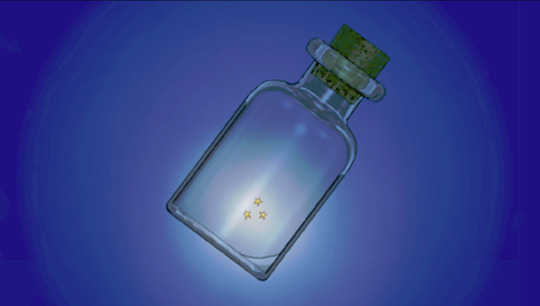
With that, more words than likely anyone has spoken in defense of this game, I’m off to take another dive into visual novel hell, soon including this game’s far more famous sequel, Ever17. Till next time. -Scout
14 notes
·
View notes
Photo

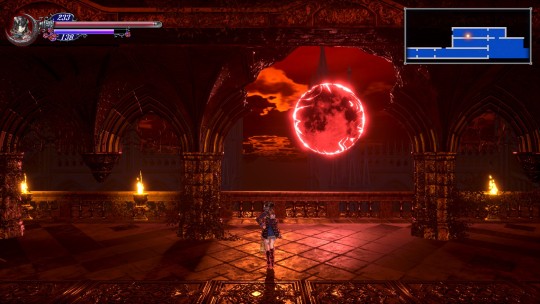

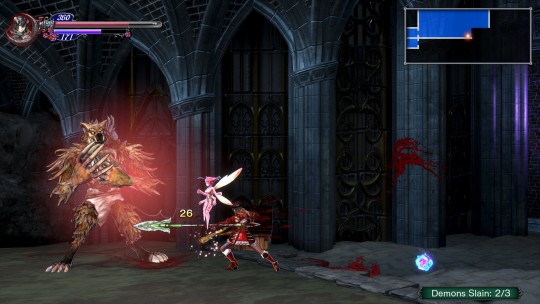
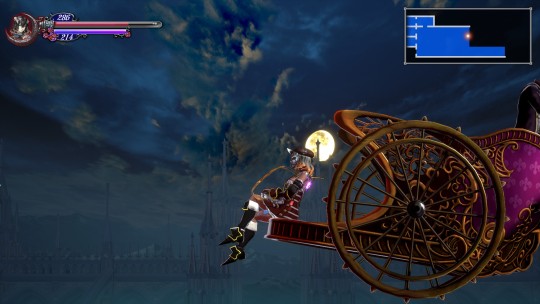


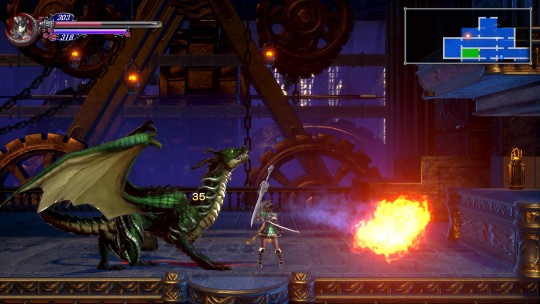
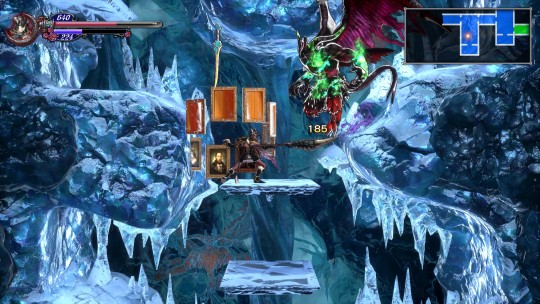
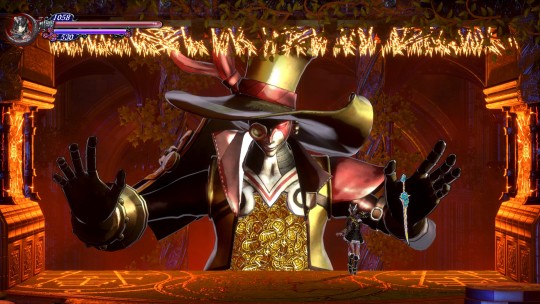
It’s Castlevania with demons, and it’s good
Quite some time ago, I highlighted Bloodstained: Ritual of the Night in a post on this blog that was all about Kickstarter spiritual successors and how they represented a bold future where franchises deemed unprofitable by big corporations could find the funding they deserved. That 2015 post has not aged especially well in 2019, since several of the Kickstarters that I mentioned were released to a middling reception...the most notable being Mighty No. 9, which is now regarded as more of a pyramid scheme by Keiji Inafune instead of a proper Megaman reboot.
Bloodstained manages to buck that unfortunate trend, despite a somewhat uncertain development process. Visualized by Koji Igarashi (IGA), a dude who I both like (for his grit at keeping the Castlevania franchise alive) and find overrated (for his odd retcons of the Castlevania timeline), the game was supposed to come out in 2017 but got hit with the delay whip again and again. As the delays piled up, so did fan outcry, especially regarding Bloodstained’s graphics, which looked washed out and a far cry from the concept art which was used to advertise the Kickstarter. Because this was the same problem faced by Mighty No. 9, everyone began forecasting Bloodstained as a similar disappointment that would fail to re-capture the magic of its predecessors and also look like mud. Thankfully, fears were lessened when new graphical shaders were implemented in the final months of development, and now the game’s rated “overwhelmingly positive” on Steam, with most agreeing that it looks fine and serves as a refined continuation of the exploration-focused “Metroidvania” style that Symphony of the Night popularized - just like how its little Kickstarter spinoff, Curse of the Moon, revived the older “Classicvania” style of the pre-Symphony titles.
Speaking as someone who gulped down all of the old Castlevanias like Halloween sugar cookies, Bloodstained isn’t as evocative or transformative as Symphony of the Night was, but it certainly does feel like Castlevania with the bad guys as demons instead of Dracula. I’d even suggest that it’s the first post-Symphony Metroidvania that doesn’t feel like it was held back by the constraints of handheld hardware. This isn’t to say that the Game Boy Advance and Nintendo DS Castlevanias were poor efforts, but they nearly all made use of recycled sprites stemming from Symphony (which in turn reused sprites from Rondo of Blood for the PC Engine), sacrificed either graphics or music due to handheld limitations (Circle of the Moon and Harmony of Dissonance) or featured odd decisions, either in game design (Order of Ecclesia’s overly tough bosses and splintered levels) or appearance (Dawn of Sorrow and Portrait of Ruin’s anime character portraits).
Of all the post-Symphony efforts, Aria of Sorrow was probably the one that had the least noticeable flaws, and when coupled with Dawn of Sorrow, that duology still serves a better story than Bloodstained’s not-especially-impressive lore. But if we’re to consider the pure gameplay of individual titles, Bloodstained is the successor to Alucard’s 32-bit romp through Dracula’s lair that a lot of people were waiting for. The game is big - taking me over 20 hours to complete, which is sizable for this genre - and it manages to capture that unique Metroidvania vibe of “here’s a giant freeform world to explore, and I can’t quite make it up to that ledge yet, but I bet when I beat a boss in five hours I’ll get some ability to nab that chest.” And indeed, once protagonist Miriam gains her full repertoire of skills - including my ultimate fave in every Metroidvania game, the ability to high jump on top of a double jump - zipping around every corner of the castle is a rush.
Bloodstained therefore manages to serve as a nice validation of all the crowdfunding optimism that spilled throughout the gaming community in 2014 and 2015. It’s also an interesting case of a Kickstarted property that seems like it’s going to exist alongside the series that inspired it. While it seems unlikely that we’ll see another Mighty No. 9 game, Bloodstained has done well enough for IGA to let on that he foresees an entire franchise in the future, and while Konami’s neglected Castlevania for years, the positive reception of the very excellent Netflix series (read all about it here and here) as well as Bloodstained’s hype seems to have made the crusty company take notice. At the moment all they’ve delivered is a collection of some of the older games and Grimoire of Souls, a meh mobile thingy that supposedly has okay fan service, but maybe IGA’s independent efforts will initialize the spirit of competition and actually get us some legit official Castlevania games again.
Barring that, at the very least we’ve got Castlevania with demons to rely on from now on.
All screenshots taken by me.
19 notes
·
View notes
Text
My Memories of Gaming in 1998
For many of us gamers, we’ve been playing games since our childhoods. If you were like me, most of your gaming years started around the early 90s. Most of the games during that time are what’s well-known, popular or mainstream nowadays. It doesn’t hurt looking back at the past of gaming and reliving those moments, either through memory or actually playing those games that came out during those times.
One time period that seems to always be mentioned is 1998. While I’m sure not a lot of people remember 1998, especially me since I was still a kid then and didn’t really care about what was going on in the world, a lot of gamers remember it as being a prominent year in gaming. This is mostly due to the fact that the games released then were sequels/prequels, innovative and influential or just commercially successful titles. While you can see a list of them here on Wikipedia, I can tell you here a little about some of the games from that year I’ve experienced. I will say, majority of these games were experienced after 1998 and were only a small play sessions or demos.
Marvel vs Capcom: Clash of Super Heroes
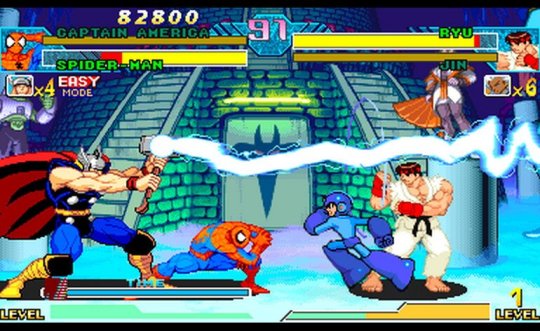
Pretty much my last time playing fighters in arcades. Mostly due to the fact that arcades were hard to come by and the closest one at the time was a 30 minute drive to the mall. Either way, seeing Ryu and MegaMan fight Wolverine and Spiderman was amazing. I wasn’t really good at the game though. I would probably win one match before either the next round or if a bigger kid came and beat me in the next match. It was one of the first games I came across that had crossover characters, which later became a feature I love in fighting games today.
Tekken 3
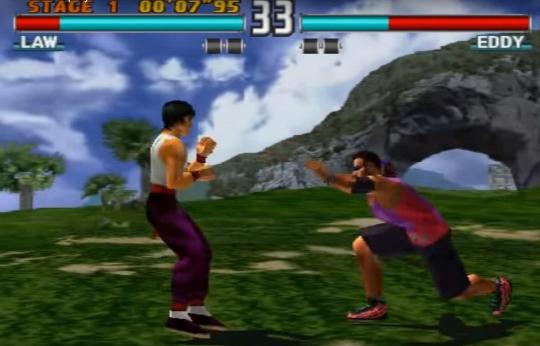
This version was just a demo of the game my cousins had, but a demo we played non-stop. The only characters available were Xiaoyu and Eddie in the demo, but once learning Eddie’s spinning kicks, we would have matches to see who was better as him. His stage music has been embedded in my mind, I’m glad NamcoBandai added the Jukebox mode in Tekken 7 (only on PS4, though) just to hear it again.
Gex: Enter the Gecko
I’ve been seeing commercials and booths advertising this game so much, I thought he was a game character I just never heard of, and there were a lot of them at the time. I got a hold of the game as a rental and played it. The cartridge I had wasn’t completed, so I continued. After not getting far, I started a new game from scratch. Needless to say, I wasn’t too interested in the game. The gecko mechanics were pretty good, but I think I had problems with attacking enemies. I remember smiling at some of the quips from Gex, but looking back at them now, they still make me smile, but only how lame they are now.
Metal Gear Solid
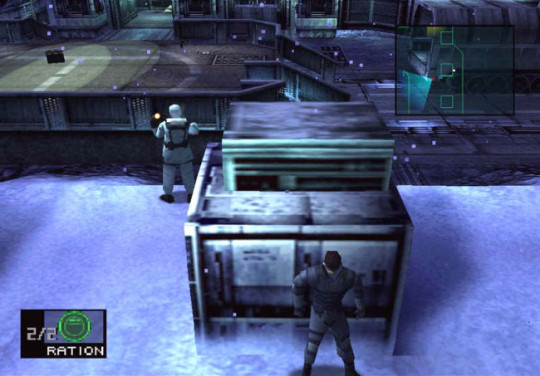
A game series that I would have never would thought would stick with me. The demo for Metal Gear Solid was so intense for me, that it took me years to actually man up and play the demo in its entirety. I remember my cousin and I were scared to get past the front entrance to the base because we didn’t know how to get pass the guards without getting caught. Hearing the screams and cries of Colonel Campbell, Dr. Naomi and Mei Ling after Snake dies were a bit too dramatic for me. Granted, this was a huge jump from Mario and Sonic games, but the interesting story, realism of the world and dramatic acting was too much for me to not know what the game was all about. After playing the demo, I wanted to play the game, but didn’t had a memory card at the time and Metal Gear Solid 2 was already out. I did finally played it, but it was the Twin Snakes version.
NASCAR 99 & Madden NFL
These were random sports games my father bought. NASCAR was bought one day after work. Madden was a Christmas gift. I wasn’t really interested in sports titles, mostly because I was not good at them. I guess it was his way to get me into sports and get me from playing games so much. I didn’t really play them much with anyone either. For some reason, Madden 97 was still fun on the PSOne.
NFL Blitz
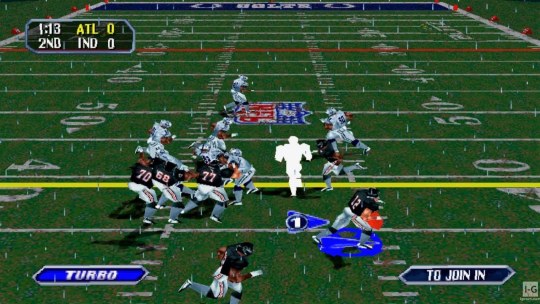
Then this bad boy came out and I was hooked! You telling me I can play a football game in arcade style AND body slam my opponents when I’m mad at a play?! Anyways, the arcade style of the game make someone like me who didn’t understand football at the time learn it quickly. Finding and printing out cheat codes for the game to put in (Headless mode, anyone?) were great, especially rushing to see who can put in the most codes (they even worked in the demo, too!). Plus, the music made each game more like an epic battle was about to go down in the stadium. One of my greatest moments was using the game to predict the Super Bowl XXXIII game between Falcons and Broncos by finally beating my cousin in the game with the Broncos. This game was the hypest shit when it came out and I only wish it continued better than it did.
Spyro the Dragon
I remember when my sister and I finally got ourselves a PSOne, it came with a Playstation Underground disc. It had some games, including Spyro the Dragon, but also promoting the game by having a behind the scenes of the development of the game. I didn’t understand most of it as a kid, but it was cool to see a look into making a game like that. The game’s music always stuck with me, especially the calming sounds of Dark Hollow and the rocking beat of the Title Screen that played in the Overworld in the demo.
Pokemon Red & Blue

Once these games came out in the US in 1998, I wasn’t too sure on what to make of it. It as a GameBoy game, which was already interesting, but it was an RPG style game that came out around the time of the virtual pet craze, which was starting to become oversaturated to me already. I guess it being an actual video game was enough to spark my interest. I only got a chance to play a bit of it thanks to a friend, but it was interesting to see a world were I can just go around, collect, fight and trade monsters and raise them to become stronger. I finally got the game a few years later, but by then Gold and Silver was about to come out.
Delta Force
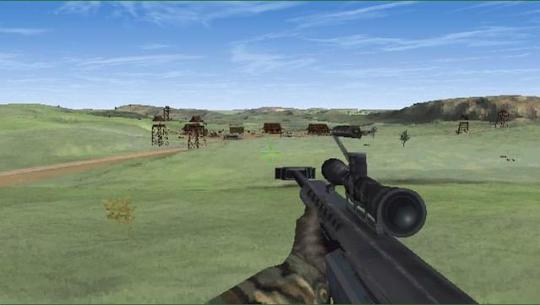
Another random game I got which I honestly don’t remember if it was for my birthday or Christmas. Regardless, this was my first experience with a military style shooter. Needless to say, this game was only loaded probably three times. The game was too realistic for me to understand how to play and PC gaming was still new to me. I thought it was just a cheap selling PC game, but I’m now learning it was a pretty popular series that had its starting in 1998.
MediEval
The demo of this game was so fun, I can’t think of any time where we would not turn on the PSOne and not play it. I remember really wanting the game when it finally came out, but unfortunately we couldn’t get it. It was interesting to see the game’s dark and gloomy atmosphere. Paired with the weird motion animation common in PSOne games back then and it made some of the cutscenes and enemy movements kinda scary. I was looking forward to playing the remake, but after hearing some of the reviews, I think I will not spoil it and just find the original and play it instead.
Crash Bandicoot: Warped
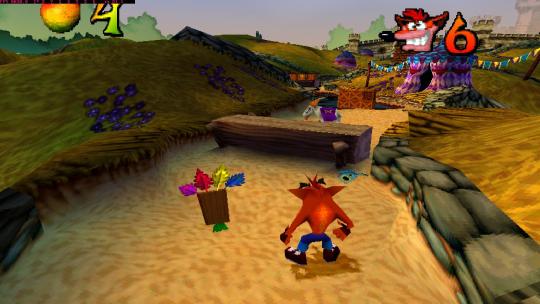
Another demo my cousins and I had that we played numerous times. The cool think it we both had different versions of the demo. One of our disc had the level were Crash is underwater, while the other had the level were Coco is riding the tiger on top of the Great Wall. We never got the game despite playing the demos so much. Usually because by then, my cousin’s PSOne was starting to wear out and we were losing interest in it.
There are other games I’ve eventually played years after their release, but after playing them and learning how popular they are and when they came out, its easy to see how 1998 could be seen as a prominent year in gaming. Its more prominent to me personally because this was a year were most of my favorite games have came out. Some of these games became important to me personally in other ways. I don’t think I would ever have a year like that in my life gaming wise, but I would like to experience more of these games from 1998.
Were there any games you played that came out in 1998 you enjoyed? What was your experience playing it?
2 notes
·
View notes
Text
Sception’s Switch Port Wish List:
Dragon Age, first game only. Fun game, even on console. Best of the series easily - the second game’s rushed dev time forced so many cut corners that there’s hardly a game left over, and the third game is so bloated with tedium that every time I try to play it my eyes glass over and I slip into a boredom coma before I can get a quarter of the way into it. But the first game? Way better on PC with mods and keyboard/mouse controls, but even so I’d jump at the chance to play it again on switch. Chances of it happening? Low. EA doesn’t want to remind people of when Bioware made good games, and they aren’t interested in releasing anything on the switch that isn’t an exploitative microtransaction store.
Mass Effect Trilogy: First game was good, second game was better, and, yeah, ok, the series didn’t finish on the best foot, the third game suffering from tone problems and a final ending that just flat out sucked, but Mass Effect 3 has a several key moments that stand out as among the best in the overall series, and while the ending is kind of bad, at least the series *has* an ending - something Dragon Age fans will probably never get to see. Chances of it happening? Again, low, for the same reason as Dragon Age.
Arkham Asylum. Just Asylum, not the rest. City’s not bad, but the loss of focus costs the experience more than the larger world and better boss encounters can win back, imo. The rest of the series, though? Bleh. Chance of it happening? I don’t know. Bunch of Warner Bros games on switch, of varying port quality. Asylum was developed by Rocksteady, not sure if that would introduce rights issues. Better chance of this than of most other games on this list.
FF6. Sure, Square has ported over PS and PS2 titles, but what about earlier ones? FF6 is the best game in the series, imo. Sure, it’s way too easy, like most JRPGs are, but the engaging story with a huge ensemble cast of likable characters is amazing. I’ve never seen a game with so many playable characters where I liked all of them this much, and the couple of multi-party dungeons reward you for spending time building up all of them. You also don’t frequently see this kind of story heavy jrpg game with a real ensemble cast, with no obvious ‘main character’, letting the player engage with whichever characters they like rather than forcing you into the shoes of a Chrono or a Cloud or some other default Hero, characters who are sometimes good but rarely the most interesting or engaging member of their respective games’ playable casts. So yeah, FF6 is great, but good portable versions aren’t easy to come by. The GBA version is amazing, but good luck getting your hands on it. The mobile port is trash. Phone emulators have to deal with awkward phone controls. A switch port - whether of the original snes version, or the PS1 port with additional pre-rendered video bits, or the GBA version with it’s not-terrible extra postgame dungeon and bosses, would be great. Chance of it happening? Frankly, I’m confused why it hasn’t happened already. Square has ported a bunch of old final fantasy games to switch, I have no idea why they cut those games off at the PS1 era. I would say the chances should be good that FF6 will come to switch, but it’s such an obvious port that the fact that it hasn’t happened already implies to me that there’s maybe some behind the scenes bullshit ruling it out. And if it does come over, it might be a port of the ios version, which would be terrible.
FFTactics. I will buy this on any platform it’s released on. But if we could get a port of the PSP version, with post game multiplayer dungeons intact? Maybe with online multiplayer support - the turn based nature of the game letting it bypass some of the lousiness of switch online? Please. Chance of it happening? Again, I’m confused why it hasn’t happened already. FF7, 8, and 9 are ported over, but not Tactics? As with FF6, it seems like an obvious and very likely port, except that it’s so obvious and so likely that the fact it hasn’t happened already maybe implies that there’s something specifically preventing it from happening. At least if they do port the ios version it wouldn’t be a tragedy here, though I would still lament the lack of the post game content from the PSP version.
Fallout 3 / New Vegas. Really Loved 3, and loved New Vegas too, though I never did get around to finishing it. Would love to see these games on the switch, provided Bethesda didn’t use the opportunity to stuff them full of microtransactions. New Vegas, despite bugs and some cut corners, remains probably the best 3d fallout game, and 3, despite the not-undeserved hate it gets for its main story, is still probably the most fun I’ve had just randomly exploring a world in a bethesda game. Chance of it happening? You’d think the chances would be ok, Bethesda’s had a bunch of games ported to switch - Skyrim, Doom, Wolvenstein, etc. That said, Fallout 3′s reputation among the Fallout fan community has plummeted in the last few years so Bethesda might not think a port would be worthwhile. And as they’re still trying to push 76, I can’t imagine their eager to remind people that their Fallout games weren’t always the hottest of garbage. So... better odds here than of Mass Effect or Dragon Age, but I’m not holding my breath. As for New Vegas, I doubt Bethesda has any interest in reminding people that the best Fallout game to be released since they picked up the license was developed by someone else.
Morrowind - Still probably the greatest Bethesda game, though I understand it was already showing the trend towards streamlining and loss of depth coming off of Daggerfall that would eventually lead us to the likes of 76 and Blades. But yeah, another classic I never got around to beating, that it would probably take a switch port to get me to try again. Chance of it happening? Some but not great, largely for similar reasons to Fallout 3. Skyrim sold quite well on Switch, IIRC, so you’d think other Elder Scrolls ports would have been a natural choice, but years later and nothing but Blades means it probably isn’t going to happen.
Mother Series, especially Earthbound - which like tactics I’ll buy and replay on any platform it’s released on - and Mother 3, which seems fantastic, but the only time I’ve tried it I didn’t make it very far due to the SNES emulator I had at the time ruining the rhythm based combat minigame. So yeah, an official port would be great. Chance of it happening? Actually good for once, for the first time on this list. As with FF6/Tactics I’m kind of surprised that it hasn’t happened already, but Nintendo being Nintendo I’m more inclined to blame that on them either just not getting around to it yet or trying to hold off on a cult classic to use it to spike excitement in a dull release window later down the line.
Demon’s Souls - Great game. Sadly my play through was killed by a hacking incident, but yeah, a classic, laid down the souls game fundamentals while pulling of some aspects better than any of the games that followed it. And a remake has officially been announced for release on PS5, would be a great opportunity to release a port of the original to the Switch market... Chance of it happening? Unfortunately, Sony owns the rights, so I just don’t see it happening... not unless Sony really plans to abandon the mobile market and instead push interaction with switch. They did include that “would you be interested in PS4 remote play on other devices - including Switch” question in a survey a while back. Still doesn’t strike me as likely, though.
Dark Souls 2 - like Fallout 3, Dark Souls 2 has become the black sheep of its series in fandom eyes. Not entirely without reason, but there’s some interesting and novel design choices that get overlooked and unappreciated as a result. I’ve never made time to play it myself, despite it sitting in my Steam library never downloaded, but would absolutely play it on the switch. Chance of it happening? Without the fan crowd clamoring for a re-release, an updated port seems unlikely.
#dragon age#mass effect#arkham asylum#ff6#fftactics#fallout 3#new vegas#morrowind#mother#demons' souls#dark souls 2
1 note
·
View note
Text
Clean MacBook Pro Keyboard
Clean MacBook Pro Keyboard To clean the display of your iMac, dampen the included cloth - or another clean, soft, and lint-free cloth - with a little water and wipe the screen. To clean the screen of your MacBook, MacBook Pro, or MacBook Air, turn off the computer and disconnect the AC adapter.
How do I clean the TV screen?
< div itemScope itemProp = "acceptedAnswer" itemType = "https://schema.org/Answer">
Current laptops have an Fn key, which is located between the Ctrl (Ctrl) and the Windows key located. Press Fn and then the Monitor On / Off key (often the F5 or F7 key). Some laptops also have a special brightness function. You can recognize them by a sun symbol.
I still have a Late 2013 and actually wanted to buy a 2018, but since I am working on the notebook keyboard, this is a no-go for me. Apple should have reacted to the keyboard problems much earlier and revised the butterfly keyboard extensively. Since the speakers of the Macbook are mainly located under the keyboard, sounds are dampened somewhat, which is not a problem with shorter videos. For long films, you should remove the keyboard protection, because it sounds better on the one hand, but also provides better cooling of the device. Save 15% when you buy the second item from kwmobile, Navaris or kalibri. Legal information € 4.99 / month after the free trial subscription expires. One subscription per family sharing group. The offer is valid for 3 months after the activation of a qualified device, starting from November 1, 2019.
Are you looking for a laptop that enables you to work reliably on the go and also impresses with its strong performance when surfing, film and series streaming?
I thought it looked a little cheap and that the keys are a little harder to press at first, but I liked the new 'look' and of course the protection for my MacBook.
Do not spray the detergent directly on the screen.
1.
1.Turn on your new iPhone, iPad, Apple TV, iPod touch or Mac device and sign in with your Apple ID. This and the fact that the film certainly looks like it will be 4 years old in 4 months make me give it only 2 stars. Unfortunately, the printed letters do not fit exactly over the original lettering, which does not bother us a bit, and the keyboard also shines a little less than without. In terms of size, it fits the device perfectly and also looks very good due to the white color. the case from your iPad first. Use a clean rag with dust cleaning mud review warm water and mild hand soap to gently clean the leather.
What to do if the sound doesn't work on the iPhone?
div>
Ctrl key. Ctrl is a key on the German-language keyboard and is essential for numerous key combinations and is located on the keyboard at the bottom left. In addition, Ctrl is located on the right edge, that is, immediately before the arrow keys.
Then you switch requests directly to Pro. I would not recommend the Air to anyone. This in turn opens up the possibility for the Surface series PCs and other Windows laptops to convince users of themselves.
1 note
·
View note
Text
Buggers, some creepy crawlies in video games!
Insects, love them or hate them, they are a part of live that almost everyone needs to deal with. Video games are no escape from this, as these critters have hooped, skittered and darted into many games. Also, even though they aren’t technically bugs, expect some eight-legged freaks to pop up as well. So grab your bug spray, grab your swatter, here are some insects in video games. Fair warning, if bugs really get to you, if seeing them can cause anxiety or panic, then skip this list. It’s ok I don’t blame you, bugs horrify me.
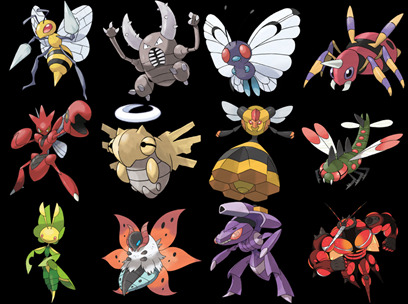
Bug type Pokemon (Pokemon) Bug type pokemon, there are too many to include just one. The bug type is realistically not that great of a type, it isn’t very strong and has many weaknesses. However, we have all had a bug type on our team before, they can be good early to mid-game, and even all the way to the champ if you know what your doing. They level up and evolve quickly and are some of the first pokemon you’ll encounter that can use status effect moves. Some bug types can actually be heavy hitters and worth the investment, and now there are even legendary bug types. So don’t put this typing down just cause it isn’t as strong as other types, bug types have a bit to offer! My personal favorite bug types by generation are… Beedrill, Scizor, Ninjask, Yanmega, Leaveany and good old Buzzwole.
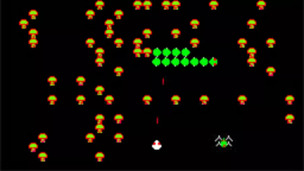
The centipede (Centipede) One of the first bugs in video games, lets sing its praise. The centipede is simple, it crawls down the screen and the player have to shoot it into pieces before it reaches the bottom. The mushrooms will block your shot so you have to align them well to defeat the monster bug. Other than that it serves no lore or greater meaning behind its existence, its just a big centipede, simple as that.

Wigglers (Super Mario Bros) Wigglers are, more often than not, peaceful creatures that walk around in a state of ignorant bliss. They often wont react at all if jumped on and will continue on their merry way. Now if you jump on their head your in for a bad time, as they will fly into a rage and dash around in a crimson fury. It is often the best option to just avoid this creature if you don’t want to get hurt.

Caterkiller (Sonic Series) This is technically cheating since it’s a robot. The caterkiller takes on the form of a caterpillar and it just slowly moves along the ground. This creature is best to just avoid, since jumping on it often results in taking damage. The rule is to aim for the head and not any other part. In some games these things can be giant, reminiscent of a sandworm. Overall they are one of the most famous badniks in the Sonic series.
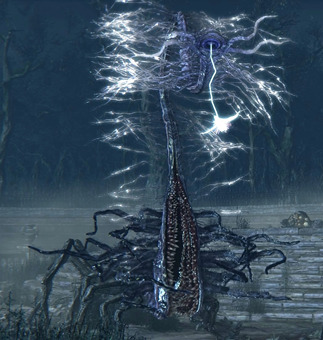
Flourescent Flower (Bloodborne) This beast is a horrifying eldritch abomination. It is a weird mixture of a plant, a centipede and a horrendous gaping maw. The creature has slow turning and is overall not to hard to defeat provided you are not standing in front of it. It attacks primarily with projectiles and can take quite a few hits to defeat. In the main game, they are rare enemies only appearing in one place that you will rarely revisit. They are more common however inside chalice dungeons.

Roolie (Bugdom) A nice little pill bug. This bug is the main character of the obscure yet cherished pc game Bugdom. Roolie must run, roll and kick his way through several levels in a quest to save his kingdom from an evil fire ant army. Roolie is a brave little bug who is up against tons of odd, including bruiser bees, horrifying spiders and even giant feet that want to crush him. However, he perseveres in his quest to save his kingdom and rescue the lady bug inhabitants.

Seltas Family (Monster Hunter) This monster family has two members, the standard Seltas and the queen. Lets cover the Seltas first. This relatively large monster is an airborne menace that likes to dart and fly out of range on the hunters weaponry. They have weak underbellies and are vulnerable to fire. The seltas will try to ram you with its horn, spit acid at you and swipe at you. If you managed to slay it, you can reap the rewards and make some armor. Now for the queen. The Seltas queen is always seen with a normal seltas, the queen is not airborne but can be carried by its underling. When alone she primarily fights with her tail and uses pheromones to call for help. These two make a deadly duo in combat.
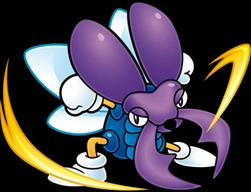
Bugzzy (Kirby Series) A recurring mini boss in the Kirby Series. This martial artist beetle can grapple the pink puff ball with his massive pincers and slam him down or throw him. He can summon other bugs to help him if he cant grab Kirby himself. Inhaling him grants Kirby some new fighting moves, and in some games you can even convert him into an ally.

Zingers (Donkey Kong Country) One of the most common enemies in the Donkey Kong series. The Zingers are large wasp that are covered in spikes, due to these spikes they cannot be jumped on. The only way to defeat a Zinger is to throw something at it or have an animal friend dispatch it. They come in different colors, each one flies in a different pattern. They love to hover around barrels and can make barrel blast jumps tricky. What’s worse is that at one point you need to venture into one of their hives.

Giant Wasp (Earth Defense Force) These guys represent the horrors that is a wasp. Fast, aggressive and intimidatingly large. These wasp dart around at high speeds and shoot projectiles at you. Since they are airborne it can be a bit tricky to take them down, as they are quite mobile. They have a bit of health too and sometimes attack in swarms or in unison with other insects. Eventually you’ll come across giant metal versions that are even faster and more dangerous than before. These guys are among some of the most annoying enemies in insect Armageddon.
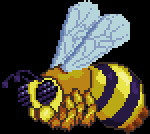
Queen Bee (Terraria) Deep in the underground jungle, you can find a beehive…Inside this beehive you can find an odd looking larvae, destroy it and prepare to meet the wrath of the queen bee. The queen bee is a very fast boss with a plethora of attacks. She has a good amount of health and the honey in the hive can hinder your movement. Do not try to fight this thing until your prepared and bring a ranged weapon! After you defeat her, you can revel in the spoils, as she drops some pretty good things. Also you get the witch doctor npc as a reward for slaying this giant bee.

Antlions (Half Life 2) Antlions are very aggressive creatures in the Half Life universe. They burrow under sandy areas and can react to surface tremors. Their nest are large and expansive. They come in five primary forms. The standard drone, which can attack in swarms, they have some flight capacity, so don’t think escaping will be easy. These drones are the most common. Next is the grey workers, they tend to not leave the nest and will spit acid at Gordan upon seeing him, they are physically weaker than the standard drone. The worm like grubs are defenseless and stick to the walls, ceiling and floors of the hive, waiting for the day they become a more capable threat. The red soldier is a ferocious large beast that is very aggressive and serves as a mini-boss of sorts, it can take a lot of punishment before going down. Finally the guardian is a soldier that guards the nest, it is very ferocious and very powerful and is best avoided.
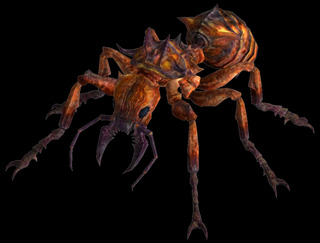
Fire Ants (Fallout 3) The wasteland is full of nasties, these buggers are among some of the worst the waste has to offer. In Fallout three, they were born out of a twisted experiment that turned a colony of ants into giant fire breathing monsters. A nearby town was destroyed by this swarm of monsters and its up to the lone wanderer to clear the place out. These monsters are perceptive, fast and deadly. Since the quest that involves them appears early in the game they can be a brick wall that takes a while to overcome. So stay on your toes and keep your gun ready and steady. Beware, for this swarm has a queen…

Frostbite Spiders (Skyrim) Do you hate spiders? I hate spiders, they are freaky and just instantly cause panic in me. Video games know arachnophobia is a legit thing, and they cash in on this bad. Get ready for some spiders, starting with the frostbite spider. These spiders make their home in many caves and some outside areas in Skyrim. They can spit venom at their foes, and can ambush people from above if they dare venture into a spider infested area. These creatures can vary in size, with some being the size of a pig to others being the size of a small house! Fire spells dispatch them pretty quickly, they seem more resistant to cold, hence their name. Try to keep an eye out for these nasties when exploring the Rift, cause they tend to pop up there often.

Cave Spiders (Minecraft) Regular spiders are bad enough in Minecraft. Spiders can crawl up vertical walls, crawl under one block openings and have a dangerous jump attack. They don’t despawn during the day either, even though they cease being hostile in the daylight. The cave spider is everything that makes a spider bad and more. The cave spider is smaller and thus harder to hit, they can inflict deadly poison on you and they tend to come from spawners. They crawl towards you in narrow corridors filled with webs, now the webs only slow you down, not them. If you decide to go deep into a mine shaft in hopes of finding rare minerals or a fortress, be ready to fight these guys.
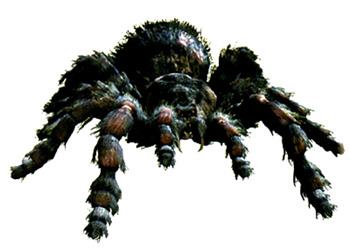
Black Tigers (Resident Evil) The Spencer Mansion and Raccoon city have a giant spider problem for sure, but one of the biggest of the bunch is the Black Tiger. This monster made its home underground and waits for unfortunate prey to stumble into its domain. It can spit acid and give a nasty bite… What’s worse is that it might have a buddy with it. After some shotgun blast to the face it will go belly up… And proceeds to spit out baby giant spiders, an arachnophobes nightmare.
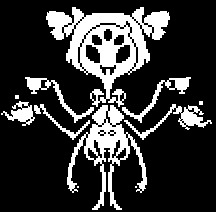
Muffet (Undertale) Who said spiders couldn’t be cute? Or sell baked goods for that matter? Muffet is both of these. She initially appears at a bake sale, selling various pastries at extremely high prices. Normally a player will not buy these items. Later, the player is forced to battle her, as she was hired by Mettaton to take you out. During the battle she will trap you in her web and send her pets at you. Survive long enough and she will receive a telegram showcasing that you either supported the spider bake sale in the ruins, or you avoided stepping on any spiders. She will let you go after this ‘misunderstanding’ comes to a close. Alternatively, you can show her your love…but you wouldn’t do that, now would you?

Phantom (Devil May Cry) A big nasty from the Devil May Cry series. This demon takes on the form of a giant lava spider and attacks Dante numerous times. He serves as the first boss and is a challenging one at that. Later on, he will attack Dante and switch to a form similar to a scorpion. This spider is arrogant and boastful of its power but is squashed by Dante. In Devil May Cry 2, he comes back for a rematch. He presumably escaped the dark pit he was sent to, only to be sent falling back into it.

Skulltula (Zelda Series) The giant spiders of the Zelda series. These monsters have a skull like design on its back and are nasty creature to come face to face with. They vary in size, from the size of a turtle to the size of a human child. These baddies usually stay attached to walls or suspended on a vine. However they will craw around if need be and can entangle their foe. These guy’s shells are tough and most attacks to the front wont harm the bigger ones, their belly is their weak point, though arrows help too. There exist a rare golden variety capable of inflicting horrible curses upon the greedy.
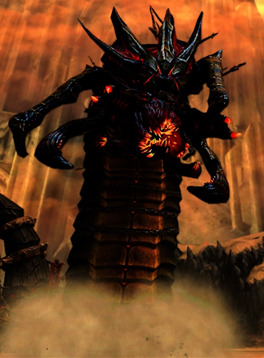
The Stygian (Darksiders) Of course there was going to be a giant worm on the list. The Stygian is a colossal sand worm that can swallow War whole. Due to its tremendous speed and size, War must ride his horse to do combat with the creature. These monster serves as one of the bosses od the original Darksiders and would do battle with War in a massive arena. Initially its mouth is closed, but its mouth is its weak point so War will have to break it open, during the fight, smaller worms may come to assist it. Upon its defeat, War enters its body and rips out its oddly small heart.

Undeep (Lost Planet) From sand to Snow, the Undeep is a huge monster encountered in Lost Planet. It is fought relatively early in the game and serves as a warning to new players to choose their battles. This creature can be avoided, and it is recommended to do so. However, a skilled tactical player can take the beast down and revel in the victory. This worm is massive and can very easily crush the player under its mass. This worm would reappear in future installments as a boss as well, however in those games your more well suited to take it down.
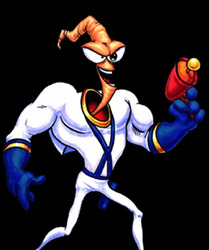
Earthworm Jim (Earthworm Jim series) Not every worm is hungry for flesh and is the size of a football stadium! This groovy worm is simply put…just a normal cartoon earthworm. What makes him special is his state of the art space suit. Armed with a energy gun, Jim makes his way through many crazy levels, avoiding deadly traps and fighting colorful villains in order to rescue Princess what’s her name. Jim can use his body as a lasso and a helicopter to navigate levels. Jim was rather prolific in the 90s, starring in 3 games and having his own cartoon series. Sadly, his third game was a bad 3D game that doomed him to the back shelf.

The Knight (Hollow Knight) I figured I would end this list with something cute. The knight is a member of the void race. The knight is a gender-less hero that fights with a nail. Over the course of the game, the knight will learn many powers and spells to aid it in combat. The knight can heal itself with its soul. The knight will encounter many hardships over its journey through its world.
------------------------------------------------------------------------------------------
Wow! This was my longest list yet! Congrats on making it to the end. Tune in next time when we look at some nice beach themed levels!
#characters#bugs#video game#games#gaming#pokemon#centipede#super mario#sonic#bloodborne#bugdom#monster hunter#kirby#donkey kong#earth defense force#terraria#half life 2#fallout#elder scrolls#skyrim#minecraft#resident evil#undertale#devil may cry#the legend of zelda#darksiders#lost planet#earthworm jim#hollow knight
577 notes
·
View notes
Text
Borderlands 3 Review
*Writer’s Note: I played this game when it came out and have based my review on the version of the game that I played then. Some of this information may become outdated with time.
DISCLAIMER: This review is going to contain a lot of spoilers for Borderlands 3, if you don’t want that then this is not the review for you. My overall opinion of this game is that it’s… okay. It entirely depends on what you value out of a video game. Borderlands 3 is, at heart, just another Borderlands that’s been somewhat dumbed down, and if you don’t like the Borderlands series’ base mechanics (i.e. farming, constantly throwing away weak gear, getting stomped on for being underleveled) then this is not the game for you. If you value storytelling in your video games, this game is absolutely not the game for you. However if you’re someone who just wants to shoot some guys and already like, or think you’ll like, Borderlands’ looting systems then this game is going to range anywhere from okay to good. It should be kept in mind that this review is meant to take into account many of the different aspects of the game, hence why this review is going to have a far lower score than many other reviewers/media publications seem to be rewarding it.
I don’t really know if Borderlands 3 is worth the $60 asking price, and I would ultimately say to either wait for the game to go on sale or at least wait for it to go up on Steam. This is because the game really is just a dumbed down Borderlands entry, you could easily just go buy the Handsome Collection for $60 (if you haven’t already) and have just as good, even better, of a time. Also that Steam has more laid back refund policies than the Epic Store (which can be blamed for this review existing in the first place). But this is where the spoiler free section ends, anything past this point will contain heavy spoilers for the sake of in depth discussion. You have been warned.
When the Borderlands 3 reveal trailer came out back in March I was entirely skeptical that the game would be anything good. The story looked like a mess, the guns looked like complete shit, and overall it appeared that a lot of the things they were promising on were too good to be true or would end up simplified. Also, at the time I had just played through the entirety of the existing Borderlands series (excluding Tales From the Borderlands), so this new game was going to have to spike a certain chord with me. This definitely wasn’t helped by the “additions” that they tried to make to those games such as second game’s graphics enhancements, and the Borderlands 1 remaster. The former, while making the game look prettier, had the problem of cutting off cross platform play (across PC, Mac, Linux, etc.) which left a small crowd of people very disappointed. And the latter had the issue of being a complete load of garbage with many of the same bugs, new performance issues, clunkier menus, new menus not working, and of course Gearbox’s patented golden chest. They pulled a BL2 and just gave you OP guns at the beginning of the game as to make the beginning area more trivial than it already was. And if that wasn’t bad enough, they suited you out with 75 golden keys for connecting your shift account, meaning that you could destroy any sense of value the guns originally had.
There was also the new BL2 dlc that was meant to tie the game into BL3’s story. However I can safely say that after having played through BL3, this dlc’s campaign in no way whatsoever connects these two games together. I guess at best it explains how Sanctuary fell, but that in of itself has a lot of problems. You get attacked by some Dahl commander (who has never been brought up in the story before) where he infects Sanctuary, and by further extension Pandora, with this plant virus. Your job is to kill this guy and stop the plant virus. There is no motivation established for this guy besides that he wants to make Pandora into some paradise, and the story has absolutely no effect on BL3 at all. The crew was already set on going to outer space, this invasion only served to speed up this process. To further this claim, there is no mention of this dlc’s events in BL3 and Pandora is still the same sandy hell scape that it normally is.
Which finally brings us to Borderlands 3. A game that feels surprisingly devoid of passion and love despite how much effort went into it. A game that feels like there wasn’t enough time to flesh out ideas. A game owned by a company who sold out to Epic for money- let’s get a couple of things out of the way first. 1. Borderlands 3 isn’t an entirely bad game per se. 2. I have relatively no issue with the game being an Epic exclusive and my opinion is not biased or soured due to Randy Pitchford’s constant fuck ups.
However, that doesn’t mean that I don’t outright despise Gearbox and 2K for their actions. They take an exclusivity deal with Epic which actively disrupts consumer convenience and confidence in purchasing their product (not a big deal). But then they have the audacity to push this game out in the buggy, unpolished, and unoptimized state that its currently in (kind of a big deal). The menus are buggy on a basic, functional level, the performance tanks constantly, and items would quite literally disappear out of thin air from my inventory. All of these made Borderlands 3 just that much more of a painstaking experience to play through.
It was the unpolished game and the Borderlands’ trademark shitty introductory area that made me want to refund the game. And believe me, I tried to refund the game. Unfortunately I got denied my refund because I had accidentally played over 2 hours of the game, when the Epic client doesn’t even show your playtime. So ultimately I had no choice but to play this game in order to get my 60 dollars worth. In that time I learned that this game is exactly like the other Borderlands games. Right down to the pacing and the disappointing endings. The beginning of Borderlands 3 is a complete slog. You’re just slapped down on Pandora and have to suffer through Clap Trap’s “hilarious” writing and get formally introduced to the mechanics of a Borderlands game for the 4th time now. Gearbox has apparently never figured out that people really hate playing through the beginning of their games because it refuses to give the players a skip tutorial option or a way to just outright bypass the introduction. Now I will say that this introduction isn’t as bad as BL2 or The Presequel, but it's certainly nowhere near good either.
The problem with these introduction areas is that they aren’t engaging or really even play into the story in any meaningful way. In BL3, you arrive out of thin air on Pandora and are forcefully met up with Lilith and the Crimson Raiders so that you can prepare to take off into space. Between meeting up and going into space you’ll be doing menial tasks such as fixing Marcus’ shops, getting a basic vehicle, and doing some really boring boss fights. Your motive for killing these bosses is because Lilith is on the hunt for the vault map. That thing that they had in BL2, how did they lose it? Nevermind that because it’s just sitting with Mouthpiece, a painfully easy boss that expects no brain power out of you other than just avoid the giant speakers that go boom. Apparently it was in Vaughn’s possession before he was betrayed by his Sun Smasher clan in return for good boy points from the Calypsos. Why the Crimson Raiders thought it would be a good idea to leave the map with Vaughn beats me, but I can safely say that this theme of Vaughn being a complete fuck up is consistent throughout the entirety of BL3.
Vaughn at best feels like a comedic relief character, and at worst feels like padding. This character has no important role throughout the story, just plainly isn’t a funny character, and comes across as a complete waste of space. He could literally just disappear from the entire game and nothing would change. You (luckily) don’t even see him for most of the game because his ass is left back on Pandora to do… something. I’ve heard that Vaughn is a far better character in Tales from the Borderlands, however as I haven’t played that game I cannot say for certain whether or not Gearbox really just dropped the ball on this one. Vaughn also isn’t the only character I have this opinion of, however as I am still discussing the game’s intro I feel that I should hold off until later.
So after you acquire the vault map and experience a “high stakes” encounter with the Calysos, Lilith loses her siren powers. I feel like this was supposed to be some big, “Oh shit,” moment but I have to express that I simply don’t care for Lilith’s character and people who are new to the Borderlands series won’t care either. Lilith is not necessarily a “good guy” in Borderlands. She has done some fucked up things that have drastically changed the overarching plotline and a lot of people’s perception of her both in the story and by players experiencing it. In The Pre-Sequel, she is framed as being the reason for Handsome Jack’s insanity as Lilith literally branded a vault symbol onto his face. In the epilogue of TPS she actively commands a firing squad to gun down Athena after she tells her story in its entirety, completely against the judgement of her colleagues. And she makes incredibly rash decisions in BL2 that causes detrimental results for the crimson raiders such as being captured by Handsome Jack after being explicitly told not to come to Angel’s prison that greatly changes the dynamic of the story. These are only a couple examples, and I could keep going, but the point is that I don’t value Lilith as an entirely productive or a beneficially proactive member of the Crimson Raiders. And new players who have never played Borderlands before literally won’t even know who Lilith is or why she is even important. Hence when Lilith loses her siren powers after a pretty pathetic fight with the Calypsos, I can really only roll my eyes and just go with it.
From here the story relatively picks up and becomes a bit more bearable (but not really), however I don’t want a couple thousand words of this review to be about the story. Overall it’s trash, and I’m going to try my best to summarize just why it’s trash. Firstly is that the Borderlands writers might be writing for way too many characters. Seriously you have: ProZ-oh I mean Flak, Amara, Zane, Moze, Vaughn, Lilith, Brick, Mordecai, Tiny Tina, Ellie, Tannis, Marcus, Zero, Rhys, Lorelei, Aurelia, Hammerlock, Typhon Deleon, The Calypsos, Katagawa, Bosses also have some writing with them, Ava, Rhys, holy shit I could just keep going. This isn’t to mention that the the only returning vault hunters from BL2 are Zero and Maya. And then factor in that the writers had to write up a ton of audio logs, some Typhon logs, Eridian logs, side quest dialogue for meaningless bosses, etc. and you have just this disaster of a story that churns everyone out to be really shallow characters. There aren’t any truly good characters in this game. Some of them are passable but that’s because they either aren't main characters or they have some somewhat funny writing and redeeming qualities.
Characters like Ava and Maya (and Vaughn) are completely devoid of any purpose within Borderlands outside of being fuel to the drama fire or just outright being an obnoxious brat. It’s pretty obvious that Ava is just a spoiled teenager who has no idea what she’s getting into, but even in the context of Borderlands her character doesn’t fit at all. For example, after the player kills the first vault monster (Rampager) and returns from the vault, you’re suited to a cutscene where Ava and Maya go pants on head retarded. Ava, a defenseless, tiny, teenager with no powers whatsoever, tries to tell Maya that, “We should be kicking [the Calypsos’] asses!” after the Calypso twins show up to absorb the powers of the vault monster. Mind you, this is after her and Maya debate about how Ava is a piece of shit that’ll get herself killed if she sneaks off to more vaults. Ava then has the audacity to tell the vampire sirens that eventually she’s going to be a siren and she’s going to, “Mop the floor with assholes like you.” These actions ultimately gets her put in her place, and Maya killed. Bottom line: She’s an obnoxious character that makes playing through the story of BL3 worse the more you’re exposed to her. And speaking of Maya, her character in Borderlands is completely useless. She introduces Ava, and then gets killed so that the players can go grrr at the big baddies. Her only significance to the story is that Maya is a siren so that the Calypso twins can steal her powers. Otherwise she is an absolutely useless character that now we’ll never get to see again without Gearbox pussying out on their own writing.
I’ll be completely honest here in saying that Typhon Deleon was the best written character in the game, and you hardly get to hear anything from him outside of backstory and the final couple hours of the game. If Typhon Deleon was a main star of BL3 I think the story would’ve went in a much more favorable direction. However I can’t discount the good writing moments within the story. Even though I absolutely hate Flak’s character even down to his voice, he does have some lines that made me chuckle. Rhys’ entire gag about Rhys ball had me laughing for that entire section, especially the line, “Suck on my big ball, Katagawa.” In fact I think most of the jokes that I laughed at were sexual jokes. I frankly don’t think a lot of these sexual jokes make the cut in a lot of games nowadays outside of obvious fanfare or really out there stuff like Grand Theft Auto 5. This was really unexpected and pulled off well in BL3 as weird as a compliment this is.
I also just want to express my disappointment for how the old vault hunters were treated in this writing: Axton, Gaige, Krieg, and Salvadore aren’t present in this game outside of some echo logs. It could be plausible that Axton and Gaige will come back for a future dlc, but I’m not holding my breath. We ultimately got Maya and Zero, and oh god these characters are bad. Maya dies only a couple hours after you meet her and Zero is comparable to a boomer dad trying to be hip with the kids. Maybe that’s the joke, in which case all I can say is, “Wow, they pulled it off really well and I’m not laughing.”
And finally, the Watcher. What the hell happened to this dude and why isn’t he in BL3? He appears at the end of TPS and is like, “You’re gonna need all of the vault hunters you can get,” however, not only do we have a very restricted roster of vault hunters, the Watcher is literally never mentioned again. Unless the Watcher is the Eridian that left all of the audio logs laying around, but what a disappointment.
I could keep going a good while if I wanted to, but that’s reserved for my videos. The next part of the game that should be brought up is the world design. Most of the world design is okay, I wish Pandora wasn’t just set in desert hell ala BL1, but other than that they seem to have enough content and discoverable areas to make them interesting to explore. My ultimate problem with the world building comes in when considering the planetary system in the game. Now this point can be entirely perceived as me just being an ass but when I think “planets” I expect a lot more than the world hubs in BL3. The planet’s levels are relatively small scale for being on, you know, a planet. And this isn’t just a problem with BL3, many other games that have incorporated planets like this, such as Destiny and Warframe, ultimately fail at capturing the scale of planets. A planet is often scaled down to a simple level within a video game, and it’s somewhat shameful to see a game boasting, “tens of planets to travel to” and then those planets have the same (and even less) scale as their previous title entries that were based on a singular world. Now I perfectly understand that this is a hard request to answer to, and having to build and construct one world is difficult on its own. Despite this, if a development/marketing team wants to promote their usage of a planetary system in their video game, it’s implied that the levels are going to be gigantic. It’s not at all impressive to see planets being used in BL3 because BL2 had the same, if not more, level variety and the same, if not more, amount of levels without the pseudo use of large scale.
This isn’t to say that the levels contained in the game are bad, just that I wish they weren’t pushed into a planetary system. Generally speaking, the levels aren’t bad. I hadn’t ever reached a part of the game where I thought, “Wow this level is trash,” or found levels that were broken. In fact, the gameplay and level design seem to be the real highlights of this game. Gameplay this time around has been modernized and sped up. Players are suited with a slide, ledge grabbing, barrel throwing, and melee slams. Sliding in of itself is important because of how non-committal it is as you can cancel a slide instantly by jumping. These additions ultimately make combat faster and more varied in how you approach the game. See Borderlands 1, 2, and TPS (while it tried) suffered from each fight encounter being basically the same shootout with basic cover systems. This time around, while you can still use the basic playstyle from the older games, you’re provided the methods to really make your gameplay interesting. Personally I never used the melee slam or the barrel throwing, and the new ledge grabbing system only serves to add verticality in map exploring from my experience. However I did use a lot of the slide, and given the right gun (especially shotguns) it became very satisfying to slide into an enemy and pop them into the air with a shotgun.
On this note, I feel like I have to express how much I disliked the feel of the guns. And clearly I am on the contrary opinion here because I have heard everyone on the planet say that, “Wow the gunplay is soooo good omg!!!” but I’ll be honest in saying that I didn’t see it here. Sure, the gunplay now feels more weighty and the new animations and stuff are nice to making the player character good gameplay feel. But the guns themselves, despite apparently having tons of funding behind making the guns sound good and being completely reworked, still have the chronic floaty-ness issues of the previous games. Some guns (primarily early game Hyperion SMGs, Maliwan guns, and some shotguns) just felt so awful to play with that I put them down and never touched them again. I’m not too sure what I was expected as I slid into an opponent and shot them in the face with my shotgun, only for them to fly away a couple feet and just get right back up only having lost about half or less of their health. Jakobs guns were consistently the best weapon, feel wise, despite me always wishing they had a bit more of a kick to them.
One of my major issues with the guns is that they are way too sci-fi and not enough like guns on wastelands and battle driven hell hole. Seriously for how terrible a place Pandora is, you don’t get weapons that reflect this attribute, Instead you get these futuristic Hyperion smgs that will project a shield out in front of you or a Torgue gun that will home into your target when thrown. This is a consistent theme throughout the game where guns won’t aesthetically match the environment. I could understand if you found futuristic guns on Promethea, or even that you find technologically advanced weaponry in the form of Hyperion leftovers on Pandora(given that they’re consistent with the styling of BL2). This would 1. Appease me, because I am the only person worth pleasing, and 2. Would allow the Gearbox developers to create more variety with their weapons so that the game actually feels like it’s hitting its promise of, “Billions of guns.”
Another issue I have is the sound design for these guns, which is probably the point I’ll get absolutely grilled for but: Using actual sampled gun sounds apparently does not work for video games. Seriously every time a game tries to improve the sound of its guns, the new sounds somehow turn out to be worse. This can easily be explained off as having a bias against change, but let's talk about it. Firstly, the guns are way too quiet in Borderlands. And they seem extra quiet in BL3, like worse than BL1 quiet. Maybe it’s a difference in subtlety, because let’s face it: It’s not like a microphone was stuck right next to an actual gun. In reality the sound designers probably had the microphone a good many feet away. This gives the gunshot more of a subtle popping sound rather than the huge blast that the person holding the gun actually experiences (hence why you wear earplugs when shooting guns in real life). But I’m going to put in my take on this matter: Guns need to have an impact in their noise. Now this doesn’t mean that guns sounds even need to be based on real guns or realistic in any shape or fashion. Borderlands is a game with a unique artstyle, so why can’t Borderlands have unique sound design?
It seems that every game nowadays wants the best sounding or most realistic guns to boot, however what happened to all that stylistic choice? Some of the best examples I can think of are Counter Strike’s western inspired whiff sounds for its older titles, Enter the Gungeon’s wide arrangement of different gun sounds, the cartoony gun shot effects for Wasted, and even Borderlands unique sound designs such as The Bane and the beam guns from TPS. These unique sound designs are missing for BL3’s guns and, despite Gearbox making an algorithm to suit one gun sound to thousands of guns, they all really sound the same. Not like you can’t tell the difference between what you’re shooting but in that all snipers sound like a generic sniper, all pistols sound like pistols. Of course you have to discount certain weapons like the Occultist that don’t even shoot the bullets respective of its weapon type. But the point is: this is a missed part of the game. I don’t necessarily like or dislike the realistic approach to the sound design of weaponry, but in a game that feels anything but realistic, the sounds aren’t doing it for me here.
But let’s reel it back to the game again, and get into the basic looting mechanics for this game. Upfront: It’s dumbed down, and takes little effort to get good gear. This is the part of the game where I fall out of my element (if I haven’t already), because I don’t really appreciate Borderlands for its RPG mechanics. It feels nice, and the act of finally getting something you grind out for hours if exhilarating (4 times magic missile), but it is far from how I prefer to play my games. Given this though, even I feel that legendaries drop way too often. Over my playthrough of just the main game content (I did 6 side quests on my first playthrough, and we’ll get to this) I collected tens of legendaries. When I was finished with the game I had 10 legendaries just sitting in my inventory that I was either actively using or keeping as a memorial item. This isn’t to mention that you literally get a chest at the end of the game that contain 4 legendaries in it. The loot dropping system is no longer satisfying at this point. And this isn’t just a matter of, “Oh they buffed the loot drops a little bit,” it’s a matter of the looting system becomes a complete joke when bosses can literally drop multiple legendaries without Mayhem, and will consistently drop multiple legendaries with Mayhem.
Assemble this with a forgiving leveling system, and now it’s just a dumbed down Borderlands experience. In previous Borderlands games, you couldn’t just do the main quest from start to finish. At some point you would eventually become underleveled, and paired with Borderlands’ trademark unforgiving and shitty rpg mechanics, meant that being 3 levels beneath an enemy granted you 10% damage reduction. This is no longer a worry, you can now play the main quests from start to finish with zero leveling hiccups. Or at least from my experience. Some reviews that I indulged in have said that they did have troubles with the leveling system, to which I rolled my eyes and had to immediately question what the hell they had done wrong. On normal mode I finished the campaign having only completed 6 side quests in total. One of these, to tie back to the looting system real quick, gave me a legendary elemental pistol that melted enemies for the next couple of zones. I also asked someone about their experience playing Borderlands 3 so far, only to learn that he had been doing every single quest that he was given and was massively overleveled come time for the first vault boss (he was level 21).
The bosses of Borderlands, this time around, were the best and the worst that the series has ever gotten. They’ve been massively revamped from the older system of AOE insta-kill moves to having actual attack patterns that you can skillfully avoid. To compensate for this, the bosses have been relatively tuned up to be more aggressive, throwing out more attacks. These new bosses range from very good to very, very bad. Some of my favorites were the Graveward, the Penn and Teller styled boss (Pain and Terror), and Troy Calypso. The bosses that I ultimately ended up hating were Katagawa, the Rampager, the Warden, and the Anointed. These bosses either suffered from boring attack patterns, bullet spongy-ness, or a lack of direction on what you’re supposed to be doing to beat the boss. Katagawa and the Warden fit into this last category. For Katagawa I was confused by him taking inconsistent damage (he loses a ton of health on shield break) and the Warden I couldn’t figure out whether or not I was allowed to kill him early. This is because the Warden is styled around the Goliath from BL2, so whenever he kills one of his teammates he gains all of his health back and then levels up. It turns out that you can kill this boss early, I just had garbage guns for this fight. So to answer your question, yes I did get the Warden to max level, and what pursued was a 20-something minute boss fight where you run the boss around in circles and turn around to deal damage when you can, and then he would kill a minion and level up. The only way I managed to kill him was that when he did eventually hit max level, he would stop focusing his minions when on low health.
The bosses that were truly good were the ones that kept the player busy, while not being too spongy or time consuming. It should be noted that the spongy factor of a boss can be easily biased by what type of weapons you enter a boss fight with. Some of the bosses I thought were easier may have actually been harder for you or another player, and vice versa. However, I will speak more of a general design philosophy and less of a, “This guy had too much health,” philosophy. I loved the Graveward (while admittedly being underwhelming for a vault monster) because of his unique battle area and clear attacks that would make his weak point exposed. Having the entire floor tilted to the side while you’re spamming jump to save your life was a fun mechanic to work with, especially when you factor in dodgeable acid balls. This was a simple boss fight that had a unique spin on an FPS boss. Terror and Pain I loved for stylistic reasons and the meta-humor around putting characters themed around Penn and Teller in a game made by a company with a CEO who is super into magic. This boss is comparable to Mouthpiece, but actually just a straight upgrade. The arena you fight Terror and Pain in is far more interesting, the boss itself looks cool, and while I have honestly forgotten the attacks that the boss had, it was still a fun encounter. One of the attacks I do remember though is the floor lighting up to indicate that fire was going to shoot up to incinerate you, and felt far more fitting than getting blasted by a speaker turned up too loud.
Something that I disliked across the board with these bosses, and this is a massive opinion piece, is that the bosses were too easy. Sometimes I honestly wished I was playing Borderlands: The Bullet Hell. I really wanted a boss that wasn’t just going to engage my attention, but make me feel like, “Holy shit, holy shit, oh my god, I am going to die.” Actually, the entire game was pretty damn easy. Although this can come down to a lot of reasons such as ally NPCs now being able to revive you, and the upped pacing of the game causing players to need to rely less on cover.
And I mean, it’s not like the game stays easy forever right? After you complete the campaign on normal mode you then unlock True Vault Hunter Mode (TVHM) and the brand new, super cool, “Badass-,” oh whoops I mean, “Guardian Ranks.” The end game is perhaps the most disappointing thing is this game for hardcore veterans of the Borderlands series. Firstly, that “reworked” end game comes in the form of the new badass ranking system, only this time you can’t disable it (This pieceo of information has become outdated with time, a future update has included the option to turn off these gaurdian perks and the passive bonuses). I mean, this time you get some rewards for using the guardian ranks? Meh. Otherwise the game still revolves around making you play it multiple times in order to get to the level cap. The only real reworked thing here is the new mayhem difficulties, annnnd they’re bad. So what the mayhem system is supposed to do is make the game more difficult while incentivizing you to play it by giving you consistently better loot rewards (more blues, purples, and legendaries). This system would otherwise be okay if not for just one problem: Mayhem 2 added no difficulty to the game, while Mayhem 3 felt typical to Borderlands end game difficulty (It should be noted that the Mayhem system has been revamped to include 10 Mayhem levels). Again, this may be because of my own personal experience with the game, see apparently Flak is outright broken when it comes to crits (Future updates have severely nerfed Flak). So this could be influencing my opinion greatly on this difficulty switch. But I’ll say that I had no reason not to play Mayhem 2, because for essentially no difficulty increase, the game started commonly dropping me blues, purples, and legendaries, while rarely spitting out a green.
At this point I had essentially had enough with the game, as my terrible, clunky inventory was constantly filling with valuables, and I had to make constant stops to dump stuff out of my inventory. Given this, the fact that Mayhem gave you a ludicrous amount of XP for very little difficulty on Mayhem 2, and a quick Google search about the raid bosses in the game, I’ve ultimately put the game down. I went from level 39 to 44 in the span of an hour, was being drowned in good loot, and the biggest sting of all: There are no raid bosses in the base game of Borderlands 3.
This is a massive review for a game that probably doesn’t deserve it. Borderlands 3 has a lot of ups and downs. It’s not a game that many people will enjoy for the story. Veteran players may have a distaste for the lack of an interesting end game. All in all, if you’re playing Borderlands 3, you’re probably playing it for the gunplay and the loot, which still, somewhat, hold up. I didn’t see how the game had a billion guns, but you know what, that’s alright. And after all of the controversy, and now that Gearbox is releasing patches, performance fixes, and balancing to the game, it’s not that bad of a game. The game just doesn’t strike me as the godlike triple A, return to Borderlands that many had hoped for. Overall, I would give the game a 6/10.
EDITOR'S NOTE: There used to be a video here demonstrating a supposed XP glitch that had occurred to me while playing through True Vault Hunter Mode while using Mayhem. It turns out that, at the time, this was an intentional mechanic for Mayhem to give you massive XP gains. To correct for this error, the video has been pulled from Youtube and this paragraph has been written, as well as all mentions of the XP glitch being pulled from this article.
-Count_
1 note
·
View note
Text
A Somewhat Comprehensive List of Good Old-School FPS Games, Where To Get Them, & How To Get Them Working
I love old FPS games. The action is fast, the levels are explorable, the guns are powerful. Whether you’re tired of modern FPS games or just waiting for some new hotness to come out, there’s a lot of these old games you can play! This list will cover a lot of the old classics and how to get them running on modern hardware (assuming you’re on Windows. Some of these work on Mac/Linux though).
Of course, what defines an “old-school” game from something more recent? Well the way I see it, there are FPS games before Halo, and FPS games after Halo. Halo was such a landmark game that it shifted the entire genre, hell even the entire video game industry. So I’m going to keep this list to pre-2001 games for the most part.
STUFF TO KNOW
Before going into this wholesale, I need to say a couple of things. These game are old. They are most likely not going to work out of the box and will need some tweaking on your part. Most of the non-3D games on Steam and GOG come with DOSBox wrappers. This can be fine for some games, but often times fans have created patches and their own engines/source ports for these games that work better than DOSBox emulation.
PC Gaming Wiki is an invaluable resource when it comes to finding patches and fixes to common problems. I will also point out any fan patches or source ports for the games as I go. On Steam, the curator page Sector Effectors has brief overviews on the functionality of games so you know what you might need before you buy.
A lot of games on Steam and GOG come in bundles that have the entire series in one at a markdown price, so it’s usually cheaper to just buy an entire series than each individual game. I can link to bundles on Steam but not on GOG; those bundles will be on the sidebar underneath the button to buy the game. In the case of games (like Doom on Steam), you have to buy the bundle to get the mission packs, whereas stuff like this is typically included with the game already on GOG.
Make sure you check through the options menu of each game and make sure everything’s set up to your liking, whether it’s video options or your actual controls. The default settings for this kind of stuff in these games are tend to be really weird and outdated, so it’s something you need to check every single time.
Most if not all of these games include various difficulty modes, so whether you’re a badass coolguy like me or someone fairly new to PC shooter games, you’ll be able to play these games.
id SOFTWARE
While they didn’t invent first-person shooter games, it’s undeniable that id Software made the genre as popular as it is today with the games they made.
WOLFENSTEIN (1992/1993/2001)
Wolfenstein was originally an adventure game for the Apple II, but the boys at id wanted to put their own spin on it. What we got was intensely fast Nazi slaughtering action, chock full of gore to spill and gold to swipe. You play as B.J. Blazkowicz, a POW hellbent on escaping Castle Wolfenstein and blasting any Nazi who gets in your way.

Wolfenstein 3D - GOG / Steam Wolfenstein 3D: Spear of Destiny - GOG / Steam Return to Castle Wolfenstein - GOG / Steam Steam Bundle
Wolf3D has a source port called ECWolf, which natively supports most popular OS’s, has widescreen support, and adds an auto-map feature which is immensely helpful for getting through the maze-like levels. At full speed, Wolf3D might make you motion sick, just a word of warning.
Return to Castle Wolfenstein has a 1.42d fanpatch (second from bottom) that adds proper widescreen support. This game has some weird difficulty spikes. Grey Matter Studios, the team that made RtCW, were later absorbed into Treyarch, who later went on to make Call of Duty: World at War and most of the other good CoD games.
Call Apogee, Say “Aardwolf”!
DOOM (1993/1994/1996)
This just might be the best game ever made, though I may be a little biased. Doom was a landmark title in the video game industry, to the point that FPS games were all called “Doom clones” for a while. The last alive in your squad of space marines, it’s you versus the legions of Hell as they take over Mars and invade Earth. Try to make it out alive!
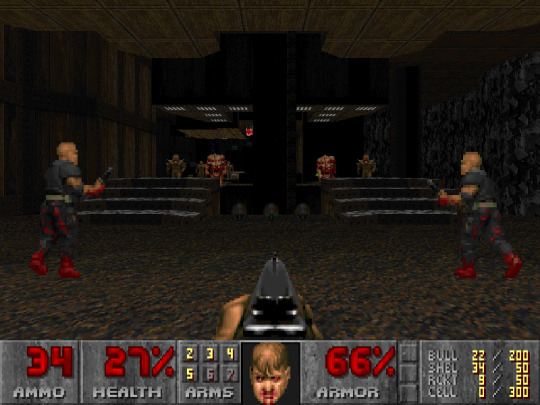
Ultimate Doom - GOG / Steam Doom II: Hell on Earth - GOG / Steam Final Doom - GOG / Steam Steam Bundle (includes Master Levels for Doom II)
Doom has a huge number of source ports, but the most notable ones as of right now (in my opinion) are GZDoom (modern features + mod support), prboom+ (vanilla-style with modern features), and Chocolate Doom (vanilla-accurate). There’s many more though, which I’ve written about extensively here. Disregard Doom 3: BFG Edition, it edits the base data files and makes them incompatible with a lot of custom content.
If you play with a gameplay mod before you’ve beaten the games, I’ll slap you.
Eat leaden death, demon.
QUAKE (1996/1997/1999)
Wolf3D and Doom were pioneers for their own reasons, and Quake’s claim to fame was its fast 3D graphics, full use of the mouse to look up, down, and all around, and intense deathmatch multiplayer. Whether you’re battling it out with Lovecraftian monsters in Gothic castles, waging war against the alien Strogg, or simply blasting opponents in the Arena Eternal, there’s intense action to be had.

Quake - GOG / Steam Quake II - GOG / Steam Quake III Arena - GOG / Steam Steam Bundle
Quake 1 has a few notable source ports. For singleplayer, Quakespasm (John Romero approved!) and Darkplaces (not updated anymore but still works great) are the go-to. I don’t really play Q1 multiplayer so I can’t recommend anything on that end. This Steam guide has some good info on Quake source ports regardless.
Another thing of note with Q1 is that the Steam version does not come with the CD audio. Short of putting a Quake disc in your computer to get that CD audio, you can download this ZIP file I put together. This page has more info about the Quake 1 soundtrack. The GOG version comes with the CD audio, but in the format of a disk image, which can be a pain to get working.
Quake II has an unofficial 3.24 patch (third from bottom) as well as source ports like Yamagi and kmquake2 (top one). Q2 also has the same problem Q1 has, in that the Steam version doesn’t have the rockin’ CD soundtrack. I put together a download for the Quake 2 soundtrack here.
Quake III Arena should just work out of install, though on Steam you might need to disable Steam Overlay as it can screw up the visuals. Outside of that though, there’s a 1.32e fanpatch and the ioquake3 source port. Unlike the previous two games, Q3A is primarily a multiplayer game, though it does have a botmatch campaign that’s fairly fun. The music should work in this one.
Shub-Niggurath awaits you...
RAVEN SOFTWARE
For a while, Raven were kind of a sister studio to id. A lot of Raven’s early games are on id Software game engines. Luckily, this means some of these games can work on source ports for the games listed above!
HERETIC & HEXEN (1994/1995/1997)
Heretic and Hexen run on the Doom engine, and actually added features that Doom originally didn’t have, like being able to look up and down, having an inventory system, having a class system, and being able to jump. Hexen itself plays fairly different from Doom, with much more focus on exploration, puzzle solving, and melee combat, with the ability to backtrack between levels.

Heretic: Shadow of the Serpent Riders - Steam HeXen: Beyond Heretic - Steam HeXen II - Steam Steam Bundle
Being Doom engine games, Heretic/Hexen can be played using source ports like GZDoom and Chocolate Doom with little to no extra hassle. Hexen actually has a CD soundtrack much like Quake, but without a CD you get the MIDI versions of the music instead, which is fine by me since the MIDI tracks are great. If you want the CD music, you can run this WAD when you run Hexen. Check my Doom guide for info on how to do that.
The version of Hexen: Deathkings of the Dark Citadel on Steam is actually the original buggy version with no music. Download this version of it instead for working music.
Hexen II uses the Quake 1 engine, but has it’s own source port called Hammer of Thyrion. Unfortunately, like Quake 1, the Steam version does not include the CD audio. You can download the soundtrack here. Hexen II on Steam also does not include the Portal of Praevus mission pack; you can download that here.
There is actually a Heretic II but it’s third-person and not sold on digital stores due to licensing issues. It’s okay, and more of an early look at a much bigger game Raven Software would make four years later.
Evil grows darkest in the shadow.
APOGEE SOFTWARE/3D REALMS
Apogee was both a developer and publisher for PC games, popularizing the “shareware” model of distribution where a sizable portion of the game would be put out for free, and people could pay for the rest of the game. Wolf3D was actually published under Apogee, but id went solo when they made Doom. Regardless, they made some very notable FPS games.
RISE OF THE TRIAD (1994)
Made on a heavily modified Wolf3D engine, Rise of the Triad was made after Tom Hall left id since Doom’s development went in a direction he wasn’t interested in. It’s much less technically impressive than Doom, though you can choose one of five characters to play as, as well as look up and down and even bounce off of bounce pads.
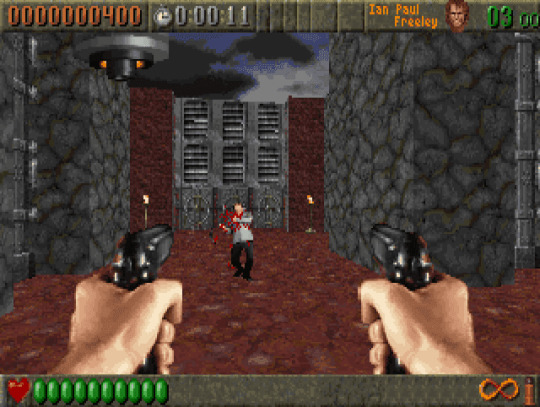
Rise of the Triad: Dark War - GOG / Steam
There is one RotT source port called WinRott (and a more modern version called WinRottAPI). However, it has numerous problems and frequently crashes, making the standard DOSBox version you get with GOG and Steam the more appealing option.
Ludicrous gibs!
DUKE NUKEM 3D (1996)
The first of the Big Build Engine Three, Duke Nukem 3D is the third game in the series, the previous two being sidescrolling shooters. Alien bastards have invaded Earth once again, and Duke Nukem takes it upon himself to blast their asses out of the galaxy, cracking one-liners along the way.

Duke Nukem 3D: 20th Anniversary World Tour - Steam
Atomic Edition is the original “all-in-one” package that includes bonus campaigns which was sold on GOG, and Megaton Edition was a modern rerelease of Atomic Edition on Steam. However, these versions of the game were ripped off of digital storefronts due to Gearbox Software acquiring the Duke IP. The only version of Duke3D to buy right now on digital stores is World Tour. It does not include the original bonus campaigns, but it has an all-new 5th episode where Duke Nukem says “Bazinga”.
Honestly, just have Atomic Edition. This is the version I had before it was taken off GOG. I don’t care. Don’t give Randy Pitchford your money.
The most notable Duke3D source port is eduke32, which adds a lot of modern bells and whistles as well as some fancy new visuals. I’m not sure it’s compatible with World Tour though.
Those alien bastards are gonna pay for shooting up my ride!
SHADOW WARRIOR (1997)
The second big Build Engine game, Shadow Warrior is fairly similar to Duke3D, albeit with a (slightly racially insensitive) Asian theme. You play as Lo Wang, chopping and blasting your way through demons and monsters to stop a corporate overlord from taking over Japan, cracking bad puns along the way.

Shadow Warrior Classic (1997) - GOG / Steam (free!) Shadow Warrior Redux - GOG / Steam
The Classic version of Shadow Warrior is just the original game running in DOSBox. It works pretty well, and for the low price of free it’s worth a play! The Redux version is essentially an official source port, like what Megaton Edition was with Duke3D. It does cost money, but it runs great.
There were a couple of source ports, but the Redux version basically invalidates them.
Who want some Wang??
BLOOD (1997)
The third big Build Engine game. Blood was made by Monolith, more well known these days for F.E.A.R. and Shadow of Mordor. Blood’s a bit of a weird one compared to Duke and Shadow Warrior; its setting is ambiguous and your main melee weapon of choice is a pitchfork. Caleb is an undead gunslinger who’s on a revenge quest, slaughtering cultists and monsters along the way while cracking snide comments.

Blood: One Whole Unit Blood - GOG / Steam
Blood is in a weird situation, where it likely would have had a rerelease similar to Duke3D Megaton or Shadow Warrior Redux, but Atari has a stranglehold on the rights and refuses to do anything with it, even release the source code.
Despite that, Blood does have a couple of source ports of sorts, the standout being BloodGDX. It’s a bizarre reverse-engineered piece of work that runs in Java, but it’s probably the most accurate version of Blood you can play besides the DOSBox version. On the downside, it doesn’t display the pre-rendered cutscenes. The alternative is BloodCM, which is based on eduke32.
There is a Blood II but it’s poopy.
I live... again!
BUNGIE
A lot of people forget Bungie made games before Halo existed. This is because most of the games they made before Halo were for the Macintosh. While Doom dominated the IBM PC market, Bungie decided to carve out a niche on a competing platform, and it worked.
MARATHON (1994/1995/1996)
The guys at Bungie thought Wolf3D and Doom were pretty cool, and they wanted to put their own spin on it. The pace is a bit slower than it’s contemporaries, but Marathon’s focus is instead on exploration and story, which is told through computer terminals. Aliens attack your colony ship, and the onboard AI start to go a little haywire. It’s up to you, a lone security officer, to beat back the Pfhor and prevent Durandal from... oh never mind, there he goes.

Marathon - Free Download Marathon 2: Durandal - Free Download Marathon Infinity - Free Download
The Marathon Trilogy in it’s entirety was put up for free by Bungie, source code and all. The main source port for it is Aleph One. It should just work after install, though you might need to fiddle with the in-game options to get it to how you want it.
All three games come with hi-res texture packs that are based on the Xbox Live Arcade version of Marathon 2, and they kinda don’t look so good sometimes. You can turn them off in the Plugins menu under Environment options to get the authentic aesthetics. The Field of View of the Marathon games is a little low by default, but you can copypaste a script from the PC Gaming Wiki page to remedy that. I played with 100 FOV personally.
Make liberal use of your automap, but conservative use of your ammo. You can only save at designated save stations. Marathon 1 has background music but the other two games don’t. Marathon Infinity’s plot includes timeline hopping. Have fun!
Frog blast the vent core!
EPIC MEGAGAMES & DIGITAL EXTREMES
Before Fortnite, before Warframe, before Gears of War, there was Unreal. Epic Games is most known for the Unreal Engine these days, but there’s a game series behind that name, and it used to be Quake’s biggest competitor.
UNREAL (1998/1999)
Like most games here, Unreal was made to be a technical showcase for the engine it’s running on. This is important because visual fidelity was pretty much the game’s main selling point, and it worked. People were really impressed with how it looked at the time. You play as a escaped convict from a prison ship that crash-landed on a mysterious alien planet, simply trying to find a way to escape.
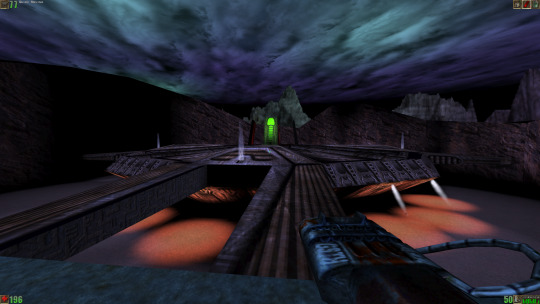
Unreal Gold - GOG / Steam Unreal Tournament GOTY - GOG / Steam Steam Bundle (includes later Unreal games)
These games should just work out of the box, but you can install the Oldunreal fanpatch to make them more compatible with modern systems and resolutions. Make sure you download the one for Unreal Gold, otherwise it won’t let you play the expansion. Unreal Tournament has a couple of patches that are needed if you want to play it online these days, as well as this fix for sound and some of the graphics.
There is an Unreal II but it wasn’t made by Epic or Digital Extremes, and it’s kind of poopy.
From where many have died, you have escaped.
VALVE SOFTWARE
Before the rise of Steam, Valve used to make games. While they don’t really do that anymore, their back catalog of developed games is impressive and impacted the industry in more ways than one.
HALF-LIFE (1998/1999/2001)
Valve’s aim with Half-Life was to make an immersive world that told a story, while also having Quake-style action as it’s main gameplay. Half-Life got a lot of praise for not only telling a decent little story, but for letting players keep control the entire time and never forcing people to watch a single cutscene. A research facility accidentally opens a portal to a border dimension, from which an alien invasion pours out. It’s up to Dr. Freeman to fight for his survival, as an all-out war commences.

Half-Life - Steam Half-Life: Opposing Force - Steam Half-Life: Blue Shift - Steam Steam Bundle (also includes Team Fortress Classic)
Half-Life is still somewhat regularly updated by Valve to keep it compatible with modern systems, so the game should just work after install. That being said, Xash3D is a reverse engineered version of GoldSrc that aims to remove some limitations and restored cut features from the original engine, though it’s not necessary to play Half-Life or it’s expansions.
There exists Half-Life: Source, which is HL1 straight ported to the HL2 engine, but it sucks. It was so bad, fans created Black Mesa, a full HL1 remaster for the HL2 engine. Black Mesa is great, but don’t play it until you’ve played the original.
They’re waiting for you, Gordon. In the test chamber...
COUNTER-STRIKE & TEAM FORTRESS
While these are strictly multiplayer-only games, I would be remiss to not include them. Counter-Strike and Team Fortress’s impacts on the world of competitive multiplayer gaming is extremely important and is worth checking out at least once.

Counter-Strike - Steam Team Fortress Classic - Steam
The original Counter-Strike should work out of the box and is still actively played by quite a number of people today. Team Fortress Classic still has a playerbase, but not as much as CS. The newest versions of these games, Counter-Strike: Global Offensive and Team Fortress 2, are still incredibly popular to this day.
Enemy spotted.
LOOKING GLASS STUDIOS
I personally don’t have much experience with Looking Glass and their legacy of games, but it just wouldn’t be right to not mention them considering how important they were to the growth of the first-person genre of games. Not strictly shooters like Doom or Quake, these games pioneered the “immersive sim” subgenre with heavy focus on exploration and story over blast-up-your-ass gunplay. If you prefer a slower pace and some actual story to sink your teeth into, look no further. Though, be prepared to wrestle with some of the controls.
ULTIMA UNDERWORLD (1992/1993)
Ultima was primarily a top-down RPG series, but Underworld takes that formula and puts it in the first-person perspective. The game pioneered many advanced features not seen before in video games, and heavily inspired games like The Elder Scrolls, Bioshock, and even Wolfenstein 3D. You play once again as The Avatar, thrown into the Great Stygian Abyss to look for an ungrateful baron’s kidnapped daughter.

Ultima Underworld: The Stygian Abyss - GOG Ultima Underworld II: Labyrinth of Worlds - GOG
There does not exist any source ports or fan patches for this game, so DOSBox is all you get. It seems that the GOG versions has a few issues, but they have fixes.
You see a rat. You see a rat. You see a rat. You see a rat. You...
SYSTEM SHOCK (1994/1999)
Video game stories about AIs going rouge and wanting to become gods seems to be a common theme in 1994. System Shock 1 and 2 are considered masterpieces by classic PC game enthusiasts. You play a cyber-hacker in the future and some corporate executive guy asks you to hack his space station’s AI to give him full control over it, in exchange for cyber implants. You agree, you do it, and as you wake from the implanting operation, the AI has pretty much killed everyone aboard and is planning on blasting major cities on on Earth with the station’s mining laser.
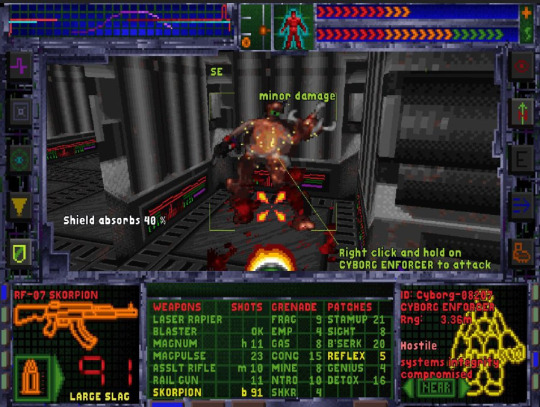
System Shock: Enhanced Edition - GOG / Steam System Shock 2 - GOG / Steam Steam Bundle
Enhanced Edition, much like some of the rereleases for the Build Engine games, is geared to make the game playable on modern systems, in more ways than one. For instance, in the original game, you cannot use the mouse to look around. Enhanced Edition lets you do so. It also comes with the original version of System Shock running in DOSBox, if you’re so inclined to play it.
System Shock 2 has a whole slew of mods and patches, too many for me to discern and sort through. Maybe I’ll update this once I actually play the game so I can put up only the worthwhile fixes and mods.
Look at you, hacker. A pathetic creature of meat and bone. Panting and sweating as you run through my corridors. How can you challenge a perfect immortal machine?
THIEF (1998/2000)
A bit of a departure from most of the games on this list, even other Looking Glass games, Thief is primarily a stealth game, focusing on moving quietly and discreetly while swiping rare artifacts and precious heirlooms. Though Garrett, the player character, often finds himself in much darker conspiracies throughout his adventures.
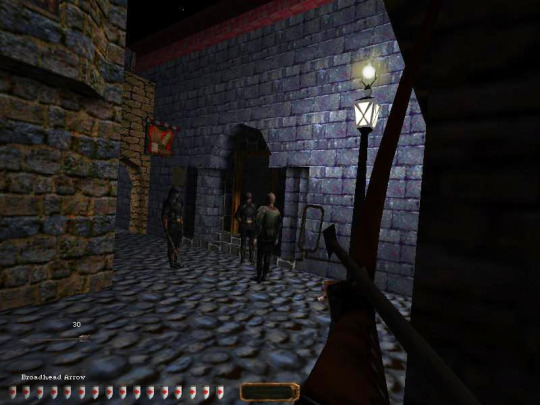
Thief: Gold - GOG / Steam Thief II: The Metal Age - GOG / Steam Steam Bundle (includes Thief 3 and the crappy Thief reboot)
Thief Gold has a patch called TFix that helps the game run on modern systems. Thief II has a similar patch called Tafferpatcher. Both games use the same engine, which was also used for System Shock 2.
Some people in The City are too rich for their own good. Lucky they have me to give them a hand.
ION STORM
Ion Storm is kind of weird to look back on in hindsight. John Romero was essentially forced out of id Software after Quake came out because he spent too much time goofing around and not actually working, so he got back with his buddy Tom Hall, and they formed Ion Storm. They managed to bring in Warren Spector and some other talent from Looking Glass as well.
DAIKATANA (2000)
Okay, I’ll be honest, this is not that good of a game, but it has historical significance so I’m including it. Mr. Romero was feeling a bit big in his britches and wanted to make the best game ever. This game would be Daikatana, featuring quite possibly the most infamous and aggressive marketing campaign in gaming history. You play as Hiro, and along with your allies Superfly and Mikiko, you must fix the timeline and prevent the evil Mishima from rewriting history and becoming ruler of the world.

Daikatana - GOG / Steam
Daikatana runs on the Quake 2 engine, which is fairly flexible and should run out of the box. Romero put out the source code for the game a year after release, and from that we got the 1.3 patch, which is still being maintained by the few fans this game has.
John Romero’s about to make you his bitch.
DEUS EX (2000)
While the Dallas studio was plagued with problems of ego, Ion Storm Austin diligently worked with Warren Spector to create the cyberpunk Deus Ex. The themes and topics in this game are honestly more relevant today than they were when the game released. You play as JC Denton, a cybernetically enhanced anti-terrorist agent who gets caught up in a web of conspiracies involving organizations like the Illuminati.
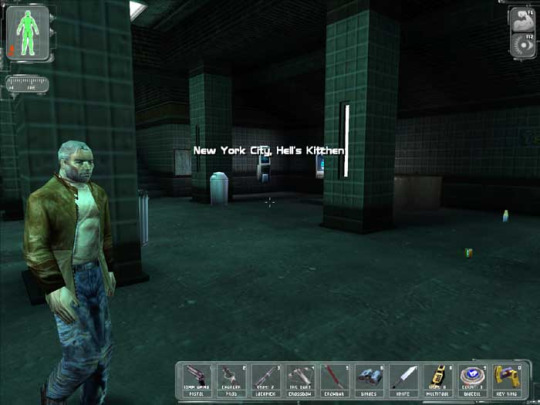
Deus Ex: Game of the Year Edition - GOG / Steam
Deus Ex runs on the Unreal engine, so it should just work. The Steam version has a bug where music is accidentally omitted from a level, but this is fixed in the GOG version. There are some fanpatches as well, though I dunno which ones are good or necessary.
There’s a Deus Ex 2 but it’s poopy.
My vision is augmented.
OTHER NOTABLE GAMES
There’s still a lot more old-school goodness to play, even though they may not be as big as the ones listed above. They may also deviate a little from definition of “old-school FPS”.
STRIFE (1996)
Even the Doom engine got an immersive sim game. Strife is a fantasy-based adventure FPS where you work with rebels to overthrow The Order. Not to be confused with Strife, the MOBA.

The Original Strife: Veteran Edition - GOG / Steam
This game was in abandonware status for the longest time before Night Dive Studios managed to find the licenses and release this modern version. It uses a fork of GZDoom and comes with a whole host of snazzy features like bloom and anti-aliasing. It even comes with the original files if you just want to play using Chocolate Doom or whatever.
DARK FORCES (1995/1997/1998)
LucasArts were famous for their adventure games, but they wanted a piece of that FPS pie too. Star Wars was and still is the hottest series in sci-fi, so it’s no surprise it had its share of games. The Dark Forces games haven’t aged quite as well as most other games on the list, but if you’re looking for that Star Wars flavor, this is it. You play as Kyle Katarn, an Imperial-turned-mercenary working for whoever forks over the most cash. The cowards at Disney retconned these games with Rogue One.

STAR WARS Dark Forces - GOG / Steam STAR WARS Jedi Knight: Dark Forces II - GOG / Steam Steam Bundle (includes the Jedi Knight games below)
The Steam versions of these games are outdated and many aspects of them just don’t work, like the music. The GOG versions are leagues more functional. Jedi Knight comes with Mysteries of the Sith, which runs on the same engine.
There are no fixes or patches for Dark Forces. XL Engine is the only source port that exists but development on it has been seemingly abandoned, and it remains buggy and unfinished. I can’t even find a proper link to a download, everything keeps 404ing.
Dark Forces II has an unofficial patch and a laundry list of various fixes on its PC Gaming Wiki page. Mysteries of the Sith is much of the same.
JEDI KNIGHT (2002/2003)
Made by Raven Software, who previously made Heretic/Hexen, Jedi Knight continues the adventures of Kyle Katarn, as he obtains the powers of the Force and wields a lightsaber. Shooting sections are in first person, but lightsaber combat is in third person.

STAR WARS Jedi Knight II: Jedi Outcast - GOG / Steam STAR WARS Jedi Knight III: Jedi Academy - GOG / Steam Steam Bundle (includes the Dark Forces games above)
Both games run on the Quake 3 engine, so they should just work fresh from install, though you might need to mess with config files to get proper widescreen resolutions. Jedi Academy still has an active playerbase for its multiplayer!
DESCENT (1995/1996/1999)
Are you sick of being limited to running around on the ground? Then Descent might be for you! Piloting a space ship, you’re given “six degrees of freedom” to bob and weave your way around enemies! You play as a merc hired by a mining corporation to investigate and destroy a computer virus that’s hijacking their mining robots.

Descent - GOG / Steam Descent II - GOG / Steam Descent 3 - GOG / Steam
There are a couple of source ports for Descent. DXX-Rebirth seems focused on maintaining the vanilla feel of the original, and D2X-XL is more focused on adding modern features, like OpenGL rendering. Both of these should work for Descent and Descent II.
Descent 3 does not have any source ports and might require some work to get running.
REDNECK RAMPAGE (1997/1998)
While Duke, Wang, and Caleb stole the show with the Build Engine, Redneck Rampage is still a favorite among some fans. Includes a booze-o-meter!

Redneck Rampage Collection - GOG / Steam
The collection includes all three games in one package. Redneck Rampage is also on Steam but the quality of that version is so poor that you’d be better off just buying the GOG version. One source port exists but is extremely buggy, so you’re better off just playing it with DOSBox.
TUROK (1997/1999)
Most commonly thought of as Nintendo 64 games, Turok did make its way to PC. Turok is a little more arcade-y than most other games of its time, using a checkpoint save system and lives instead of just restarting the level over again like other games. Commit dinozoid genocide as Turok, Son of Stone!

Turok: Dinosaur Hunter - GOG / Steam Turok 2: Seeds of Evil - GOG / Steam
These versions of Turok are remasters done by Night Dive Studios, so they should just work with no issues. N64 soundtrack best soundtrack. They’re drum-tastic!
SERIOUS SAM (2001/2002)
Out of Croatia comes Serious Sam. Including Serious Sam as an “old-school” FPS is pushing it, considering the series was actually made as a throwback to old-school FPS. At this point, it’s done its best to keep old-school traditions alive, so it deserves inclusion. You play as “Serious” Sam Stone, traveling through time to thwart the evil alien Mental.
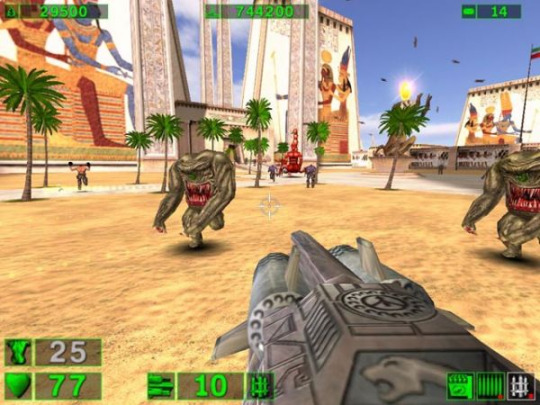
Serious Sam: The First Encounter - GOG / Steam Serious Sam: The Second Encounter - GOG / Steam
Serious Sam HD: The First Encounter - Steam Serious Sam HD: The Second Encounter - Steam
Croteam remade TFE and TSE in a newer version of their Serious Engine, and while the HD versions are the ones I’d personally recommend, the original versions still work great and some people still swear by them over the HD versions. It’s up to you and your preferences.
LET’S WRAP THIS UP
Obviously this list is not the end-all-be-all of EVERY first-person shooter that’s considered “old-school”. There’s pre-Wolf3D stuff like Hovertank 3D and Catacomb 3D. There’s stuff during the mid-late 90s like Blake Stone, Soldier of Fortune, SiN, and Tribes. Hell, there’s even stuff like Rainbow Six and Medal of Honor: Allied Assault, which paved the way for Call of Duty and the rise of modern military FPS. I never promised a full comprehensive list, just stuff I think is notable and fun. Though if you think there’s something vital that’s missing, let me know and I might add it!
If you need help getting some of this stuff to run, I will help if you shoot me a message, but please actually Google your problems before coming to me. Other people have this stuff figured out pretty well, and I will pretty much Google your problem if it’s something I don’t know.
Regardless, please check out these games and have fun! Each one has its own quirks. And remember:

465 notes
·
View notes
Text
Ys 1 & 2 review: the 22 year long journey to American computers
Falcom is one of the big underdogs of Japanese game developers, at least outside of Japan, a role pretty unfair for them considering they’re also one of the most important Japanese game developers to exist. Before names like Final Fantasy and even Dragon Quest were around, Falcom was pioneering action RPGs, JRPGs, and even innovating video game music as a whole. Dragon Slayer, the title that set the foundation for action RPGs, would eventually transform into the Legend of Heroes, better known as the Kiseki, or Trails, series, boasting some of the most detailed JRPGs out there, while the other big innovator, Ys, would remain true to its roots, while still taking steps to innovate as much as possible with every new title. Despite their games both being very influential and just plain great in of themselves, Falcom was basically unknown outside of Japan for decades due to very inconsistent localizations, and mostly being released on more niche consoles even when it did happen, like the Sega Master System or the TurboGrafx-16. The only Ys game to make it to American shores on the Genesis or SNES was Ys 3, which was barely recognizable as an Ys game in its original form, gameplay wise, and the first exposure America got to the Legend of Heroes was the Gagharv trilogy on the PSP, which recieved such awful localizations that they were actually released out of order, with the second game actually being released first, instead of the actual first, cause that certainly isn’t capable of causing problems. Thankfully, since 2010, XSEED has delivered fantastic localizations of many, many significant Falcom games released both before and after, giving fantastic games like Trails in the Sky exposure only dreamed of before. They’ve still got a ways to go, though, and so, it’s time for me to show my appreciation for these games by covering Ys 1 & 2, the games that refined the action RPG genre, farther than just starting it. The version I’m covering is Ys 1 & 2 Chronicles Plus on Steam and GOG, one of the most recent, and refined, versions available, and is based off the PSP version, which is based off the PC remakes. It’s a pretty crazy history for these games.
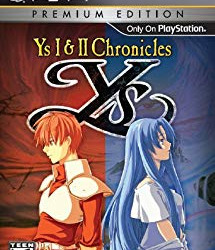
Ys 1: Ancient Ys Vanished: Omen
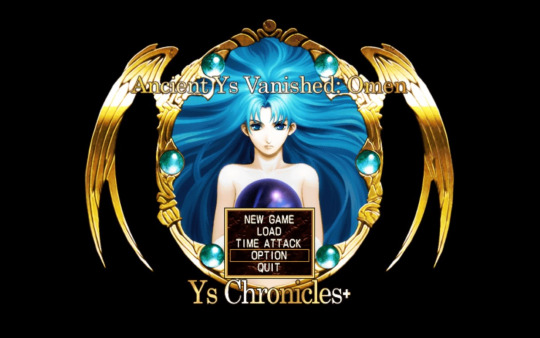
Story:
The story of Ys 1 is about the titular land of Ys (pronounced ees, like ease, or the middle part of geese), a mysterious floating island, which was, in ancient times, part of the island of Esteria. Ys was said to be watched over by twin goddesses and six great priests, named Tovah, Dabbie, Hadal, Mesa, Gemma, and Fact, until a mysterious evil forced them to raise Ys into the sky, with a few descendants of the priests and a gigantic crater being among the only remnants of Ys left in Esteria. 700 years later, odd things are happening in Esteria, with a wall of storms appearing to surround the island, cutting it off from the rest of the world. On the island itself, monsters have suddenly appeared as well, and something is stealing anything made of silver from the inhabitants, even resorting to assault. In the middle of this, the red haired swordsman Adol Christin, fueled partly by intense wanderlust, sets off to Esteria to investigate... only to predictably shipwreck against the Stormwall, washing up on the island and being rescued by the citizens of port Barbado, setting a fantastic standard for himself to repeat several times in future games. After setting out and reaching the town of Minea, Adol allies with the fortuneteller Sara, a descendant of priest Tovah, and sets off to collect the 6 Books of Ys, written by the priests, said to contain the secrets to the rise and fall of Ys, and the power to save Esteria, along the way meeting Feena, an amnesiac girl specifically imprisoned by the monsters, Reah, a troubadour with a silver harmonica, Luta Gemma, another descendant of the priests, and Adol’s future traveling companion Dogi, who has a hilariously small role considering his role in future games.
It’s definitely nothing too deep by today’s standards, not helped by the game’s short length, but having such an old game, we’re talking 1987, have an active focus on the story is pretty impressive, and to its credit, it does manage to make Ys genuinely mysterious, with an interesting explanation behind its fall, namely, the valuable metal of Ys, Cleria, caused the summoning of demons, and its discovery in Esteria, mistaken for silver, led to the island’s current troubles. While the characters as a whole aren’t anything special either, they have a likeable quality to them, and the main villain does have a fairly interesting twist to him; he’s also a descendant of one of the priests, Fact, out to collect the books for his own purposes. That said, the main strength of writing is just the general dialogue itself. For such an old game, the remakes added a lot of detail to the NPCs, giving everyone a name and a personality, and the translation gives a lot of life to them, making them pretty fun to talk to, turning what would otherwise be a lot of empty dialogue into amusing moments. They even gain new dialogue after certain points in the plot, which is another nice touch.
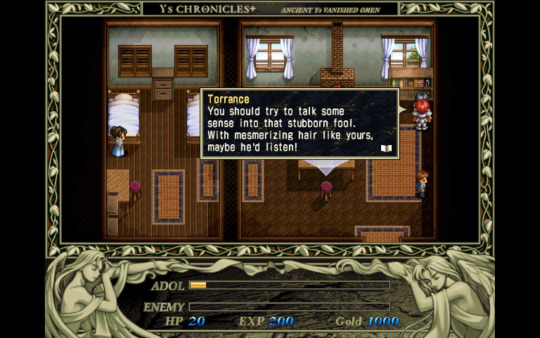
Overall, though, the biggest strength concerning the plot itself is the actual dedication put into it just relative to the time it was released. Touches like the Books of Ys being in a completely different language than what Adol knows, forcing him to find a way to translate them, and Luta Gemma’s mentions of guiding dreams, something that would become a much more common occurrence in the sequel. Speaking of which, this game was clearly betting on having a sequel with its plot, which is a pretty ballsy move even now. The deeper details to the downfall of Ys, the mysteries behind characters like Feena and Reah, and just what Ys itself is really like are left unanswered, with the game ending on an outright cliffhanger, with the books transporting Adol to Ys after saving Esteria, very likely one of the first video games to do so, at least in regards to following up on it. Overall, the writing side is still entertaining enough, and as long as it manages to be fun, that’s a success in my book.
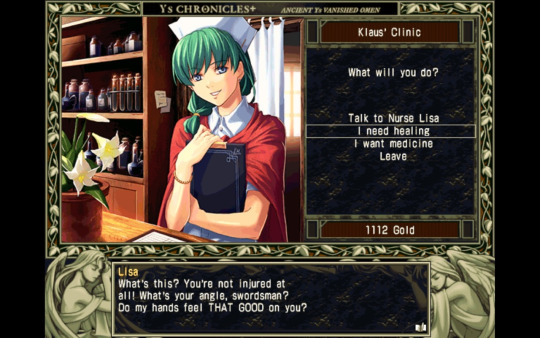
Gameplay:
Here’s where stuff gets a bit, let’s say, contentious. Ys is played at a top down angle with you controlling Adol, and only Adol. Combat, compared to almost any other video game, even from the 80's, is rather unusual. You see, instead of using a dedicated attack button, Adol suffices with ramming into his enemies, swinging his sword and damaging them automatically on contact. This system, called the Bump system, may sound, well, dumb and overly simple, but it’s quite a bit more complicated than it may seem. Running directly into an enemy, rather sensibly, kills Adol dead in just a few hits, though he at least trades hits with them as well. In order to attack safely, you need to hit them at a vulnerable angle, such as to the side or behind them. Thankfully, you don’t need to pull hit and runs for every individual attack, as once you hit an enemy at a good angle, you can just keep moving forward and attacking, with them being unable to resist unless you choose to move away, or are knocked back by another enemy. While it can be difficult to put to use at first, it’s actually a fairly well designed system. It gives the game a fast and surprisingly intense pace, with enemies being able to kill you in just a few hits, and having telegraphed attacks of their own in addition to being able to hurt you just through collision. On the opposite side, being able to run into enemies and kill them in a second is pretty satisfying, and makes grinding for EXP and gold a lot less troublesome than usual in RPGs, considering you can just take things down on your way to something else. The game also takes mercy and allows you to automatically regenerate your HP on the overworld and in towns just by standing still for a few seconds, and considering enemies only respawn when you move the screen, it isn’t much of a risk to you either to just stop and take a breather.
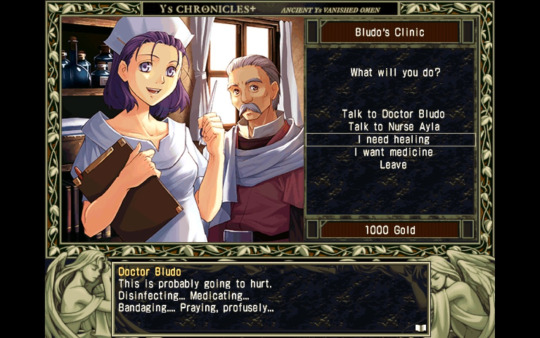
Adol’s equipment consists of swords, shields, armor, and rings. The first three are pretty self explanatory, boosting his attack and defense, and acquired by buying them in shops, finding them in treasure chests, or even received from NPCs for free in a couple of cases, while the rings give effects like boosting attack or defense, slowing down enemies, or boosting health regeneration, either doubling it when Adol is outside, or allowing it in dungeons, where it is normally restricted, though unfortunately the rings do not work in boss battles. Adol also has a regular inventory, mostly containing key items, including a few equip able ones like a mask revealing secret passages, and a few other things like potions to restore health and wings to instantly transport him back to Minea. As this is an RPG, there’s also a leveling system, which gives Adol downright dramatic stat increases each time he gains a level. Problem is, these levels matter way more than equipment, and with the jump between each level, the early game consists of just grinding a few levels until you’re capable of taking on the next set of enemies somewhat safely, with several bosses in particular being outright immune to damage until you reach certain levels. At the least, you don’t have to do this many times, considering the level cap is only 10, which you need to reach to beat the third boss out of seven, after which you’re at the mercy of any equipment the game gives you to get any stronger. Speaking of which, bosses mix up the gameplay a bit by being vulnerable at any angle, meaning you just have to focus on getting to them in between their attacks. Unfortunately, most of the bosses aren’t exactly great, either being really easy, or really, really annoying, with special mentions going to the previously mentioned third boss, which spends most of its time as a swarm of bats capable of covering most of the screen, only being vulnerable when it reforms for the briefest of moments, and we’re talking barely a second. Sometimes it’ll reform almost immediately after transforming, but other times it’ll chase Adol much longer, and it stays as the bat swarm longer if you get hit. It doesn’t take much damage even when you do hit it, as a cherry on top, making for a very drawn out fight.
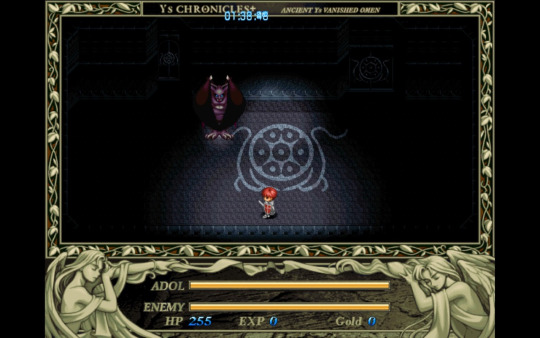
The 4 bosses after this one are a lot more fun, at least. From a giant mantis that constantly throws scythes at you, to a giant rock creature constantly firing projectiles at near bullet hell levels, to two giant floating heads bouncing around a room with barriers around them, forcing you to slip in between the barriers to hit while they swap between who is vulnerable, they’re legitimately intense, and a lot of fun, culminating with Dark Fact himself as the insane final boss, ping ponging around a room, firing near impossible to dodge projectiles, turning it into a game of rushing to meet him once you can predict his path and damaging him as much as you can, while he destroys parts of the floor for every hit he takes, killing you if you’re not on a different tile when he destroys it. It’s a nightmare attempting it at first, especially since you can’t even use your best equipment, as he is immune to any sword that isn’t the silver sword, and will kill you near instantly if you don’t use the silver armor and shield, and the instant death floor destruction is a cheap move, especially since you can outright get trapped if the right tiles get broken, nearly always forcing you to reload. Still, it’s actually pretty fun once you get the hang of it, and certainly lets the villain live up to the hype he built up. It should be mentioned there’s also a time attack mode that lets you go through a boss rush. It’s actually pretty fun, if let down by some of the roadblocks a few bosses present.
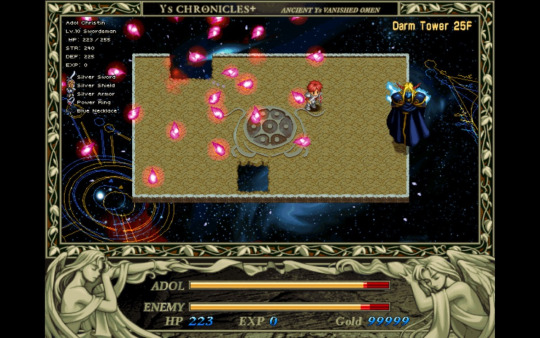
While at its core, Ys is an enjoyable time, there is one pretty difficult to ignore aspect to it: it is a very short game. There’s only three towns, a fairly small overworld, and three dungeons to go through. The first two dungeons, an old palace and a mine, are pretty decently lengthy, with quite a bit of stuff to find, but otherwise, it’s just a lot of backtracking and grinding. There’s not much in the way of puzzles, either, mostly only a few in the final dungeon. Once you’re forced into Darm Tower, with a full set of silver equipment and half of the books in your possession, you don’t think this last dungeon will be much. But that’s when the game throws you for a loop. Darm Tower is a behemoth of a dungeon, at a massive 25 floors you have to trudge through, with plenty of detours and backtracking. There’s new enemies every few floors, and 4 whole bosses are contained in this place. In the original versions, it easily took up half the game, and even in the newer versions, it’s a third of the game at minimum, if you spend enough goofing off. I have some mixed feelings towards this place. It’s miserably long and difficult, that mostly just has the same look to it in each floor, and even the music is the same until towards the end, not to mention once you go in, you’re stuck, and forced to keep on marching until you reach the top. On the other hand, I kinda like it just because of how unique it is. Darm Tower is hyped up even during the intro to the game, and plenty of NPCs say it to be an awful, fearsome place. If you’re savvy with RPGs, you might figure it won’t live up to that... but no, it lives up to all the hype it’s given. It’s utterly massive and exhausting, with tons of dangerous enemies that’ll hunt you down relentlessly. They’re even able to stick in plenty of plot and characters within, and seeing the day slowly turning to night as you make progress is quite a sight. In just living up to, and even surpassing, this hype, I kinda have to respect it. Overall, the gameplay of Ys works a lot better than you’d expect, successfully polished through over 20 years of remakes, but the short length alone could make it a difficult recommendation on its own.
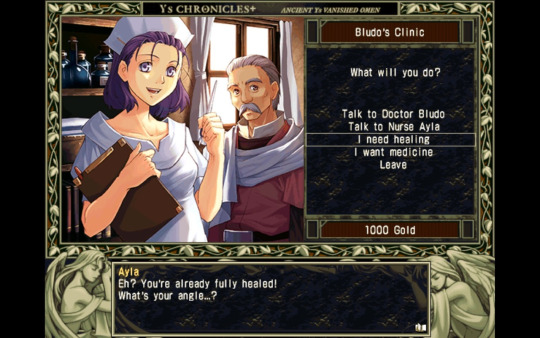
Graphics:
Ys is actually a very pretty game to look at. The characters and regular enemies are in a sort of chibi style, which is pretty adorable, but not too detailed by themselves. The environments, on the other hand, look great, with lots of little details and allowing some fantastic views. While the enemy designs and locations aren’t anything too special, they still look quite good, especially the bosses, which are significantly bigger than normal enemies. Enemies also explode in a cloud of blood, bones, and body parts when defeated, which is both funny and satisfying, while not being anything too gruesome. You may have also noticed the border portrait in these screen shots, which I find quite nice to look at, if a bit restricting. You are allowed to go completely full screen, though, if it’s not to your tastes, but it doesn’t actually cut anything off.
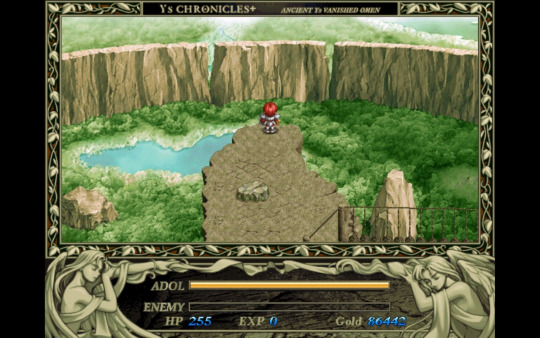
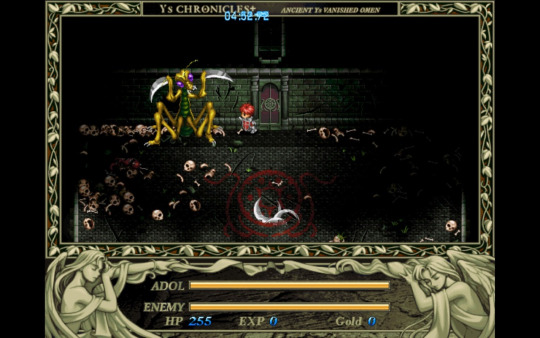
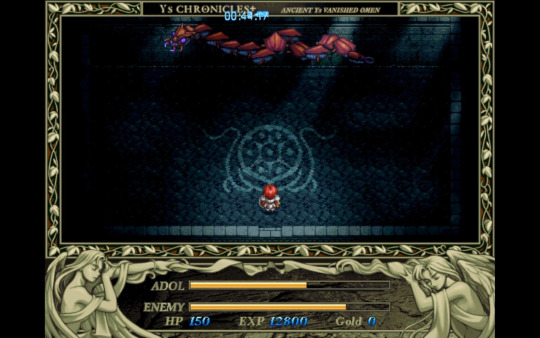
The best aspect of the visuals, though, is the character artwork used when talking to important characters. It looks absolutely beautiful, and is a good contrast against the otherwise lesser detailed sprites.
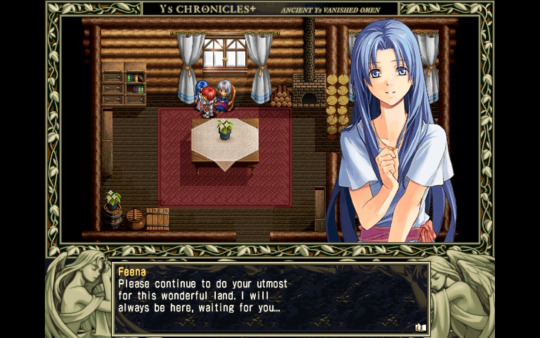
This version also goes above and beyond in this regard by giving you options regarding this character artwork, namely a choice between using the newer artwork made specifically for this version, Ys 1 & 2 Chronicles, and the older artwork originally used in Ys 1 & 2 Complete, the PC remakes that have served as the basis for almost every port of these games since their release. Which you use comes down to a matter of preference, and while I do find the Complete artwork to look a bit odd at times, overall both options are beautiful. (Chronicles artwork is used first in these comparisons, and Complete artwork is used second)
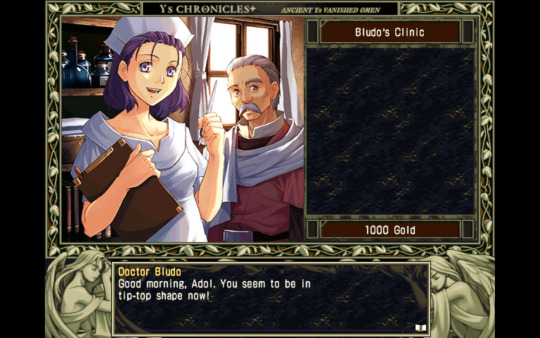
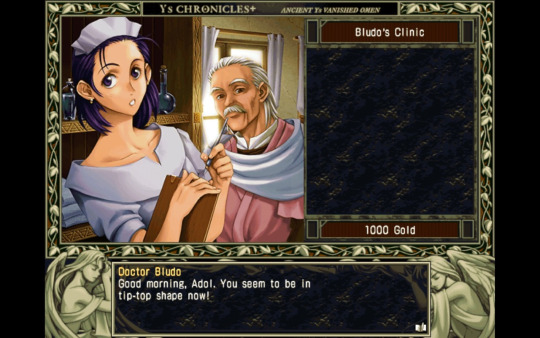
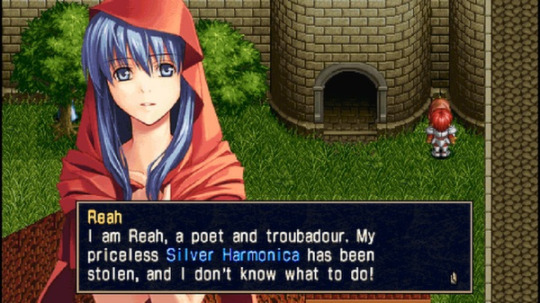
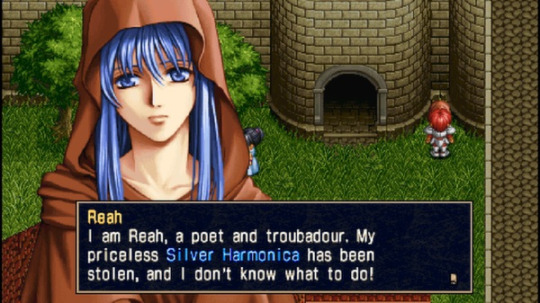
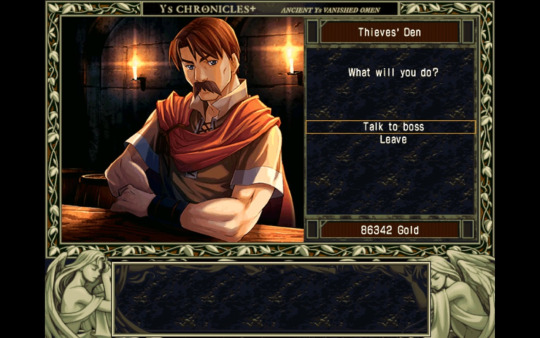
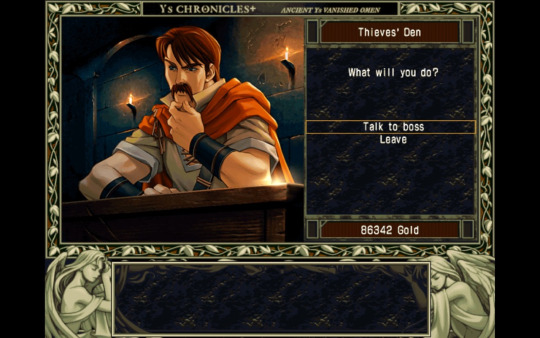
Sound:
Ys 1 has an absolutely fantastic soundtrack, courtesy of Yuzo Koshiro, also known for the soundtracks for The Revenge of Shinobi, Etrian Odyssey, and, probably most famously, Streets of Rage, setting a standard for Falcom games in general, and providing quite an influence on video game music as a whole. This version again gives options in regards to the soundtrack, giving three different versions to choose: the original soundtrack on the PC-88, which holds up well even today, the Complete soundtrack, which gives a refreshing and different take on several songs, even if it’s very blatant in being in MIDI at times, and a new soundtrack recorded specifically for this version yet again, which is amazingly metal. It, again, comes down to preference, though while I like all of them quite a bit, I easily like the Chronicles soundtrack best, though it’s telling when the original PC-88 version of the title screen theme, Feena, is just as pretty as the other versions. Speaking of which, when it comes to individual pieces, some big standouts to me are Feena, again, for the title screen, Palace of Destruction, the theme of the first dungeon, Fountain of Love, Minea’s theme, Tower of the Shadow of Death, the maddening theme of Darm Tower, and Dreaming, played during a memorable maze section of Darm Tower. It is, overall, among some of the best music I’ve heard in a game, and is worth looking up even if you otherwise have no interest in Ys.
Ys 2: Ancient Ys Vanished: The Final Chapter
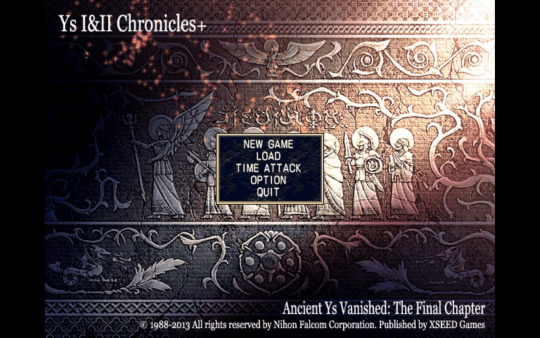
Ys 1 and 2 are so tightly connected to each other that I could not go without giving both games a proper looking through. Most releases of them nowadays can’t either, with almost everything bundling them together, which makes the short length of both a lot more acceptable, especially if you look at them as two split up parts of one game, like the acclaimed TurboGrafx-16 version did.
Story:
Ys 2 picks up right where Ys 1 left off, with Adol being transported to Ys itself. Unfortunately, his journey is not too smooth, resulting in him ending up unconscious and losing everything except for the six Books of Ys, eventually being rescued by a girl named Lilia and taken to her home of Lance Village. At least it wasn’t a shipwreck this time. But yes, as it turns out, people still live on Ys, and lived so in peace, until the same events that caused monsters to appear on Esteria caused the demons that once devastated Ys to reemerge. After being told that returning each tome to the sanctuaries of each great priest would open the way to the Shrine of Solomon, the former temple of the twin goddesses, and the current base of locations of the leaders of the demons, Adol sets off once again, to restore peace to Ys once and for all.
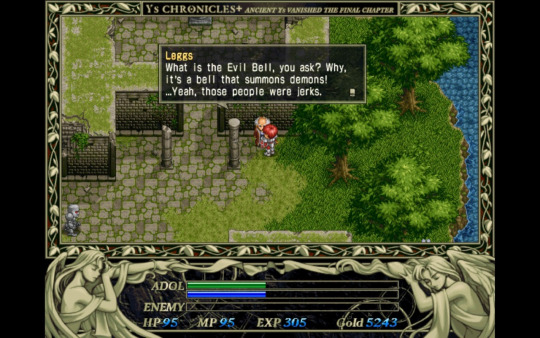
There unfortunately isn’t that much more for me to say regarding the writing. It’s about the same quality as the original when it comes to plot and characters, but overall, it’s a good conclusion to this tale, and the general dialogue is as entertaining as ever. I will say, though, that the tone works quite well, carrying a somber feeling reflecting the misery of the people of Ys, and their wish to return to happier times. Additionally, using a certain spell in the game, Adol is able to talk to the demons on friendly terms, and every one of them has unique dialogue. Not every type of enemy, every enemy has unique dialogue. Some of it is informative, but others just seem to be Falcom and/or XSEED going out of their way to prove how dedicated they are to detail, and I for one love it. Another notable thing to me is the setting of Ys itself. Esteria was a fairly normal location, but for such a mythical place... Ys itself isn’t too much different. It has some more extreme environments, like an ice wall and lava filled caverns, but it’s remarkably normal otherwise. While this may come off as disappointing, it fits quite well, considering Ys was never meant to be so grand and mysterious, and is a relatively normal place forced into an abnormal situation. Overall, again, it is a solid conclusion and step forward.
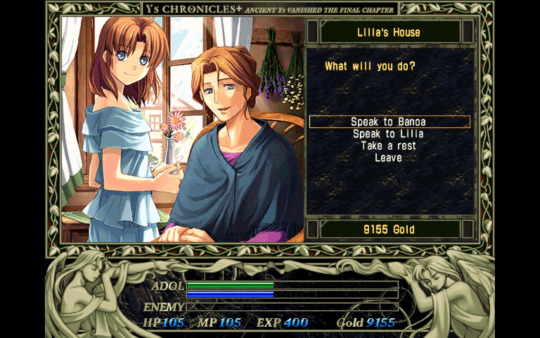
Gameplay:
The gameplay of Ys 2 is more or less the same as Ys 1, for the most part, divisive bump system and all. It does, however, feature several improvements, mostly to the combat. Firstly, the bump system has been changed so that ramming an enemy while moving diagonally will always count as a safe hit for Adol, making combat a lot safer, and enemies generally don’t deal as much damage either. The level system has also been revamped, going from the paltry level cap of 10 to a level cap of 55, meaning you’ll be leveling up and improving till the end of the game. Conversely, individual levels don’t mean nearly as much, but not only are they easier to grind for when necessary, they also make equipment much more important. The biggest gameplay addition, however, is the magic system. Over the course of the game, Adol gains several spells, most notably a spell to shoot fireballs, which can be shot rapidly or charged for a stronger attack, but also includes a spell to temporarily stop time, freezing enemies in place and leaving them defenseless, a passive, yet constantly active spell that reveals secret passages, a spell that allows Adol to appear as a demon, allowing the previously mentioned interactions, and even a spell that can warp him between various towns and other important locations, something that proves extremely helpful. This system alone adds so much to the game, and is a great way of expanding upon the rather limited system of the first game. Accessories have also been overhauled, as rather than just rings with simple effects, they’re various objects with much more unique effects, such as yet another ring that occasionally allows Adol to parry an attack, and an idol that gives homing properties to his fireballs. All bosses except for the last two now require the use of the fireball spell to defeat, making them a lot more reliant on skill than just being at the right level, making them a lot more fun as well, while retaining the frantic feel.
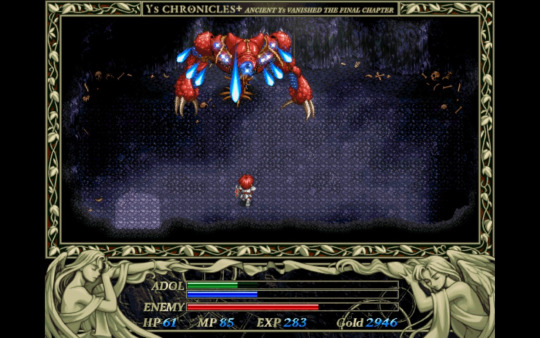
Another addition is the ability to give items like flowers and apples to NPCs as gifts. A few of them will reward you with valuable information, or even items, but for the majority, all you get is some amusing dialogue, all of which is unique, once again proving how insane these writers and localizers can be. You can also choose to throw fireballs at them, causing them to shout some pretty funny comments, which often include references to other games like River City Ransom and Final Fantasy 6. Still, it’s not very practical considering it lowers their affection, requiring more gifts just to get back to neutral. While it doesn’t affect normal dialogue, this little system is worth messing around with, just to see what laughs you can get from it.
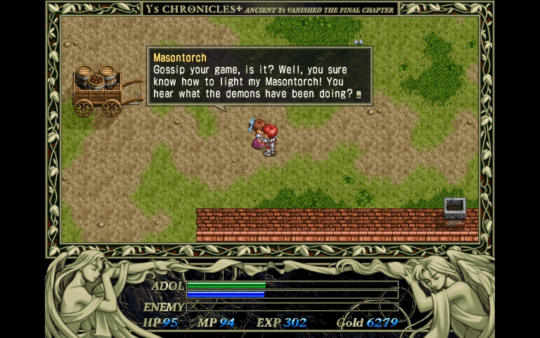
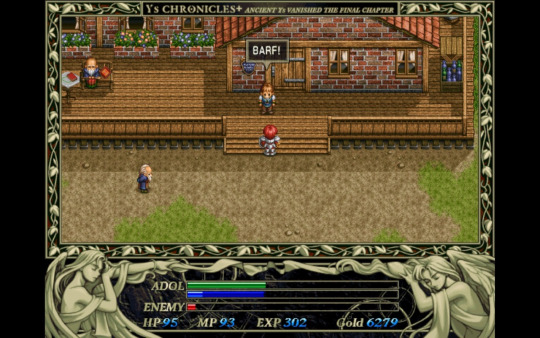
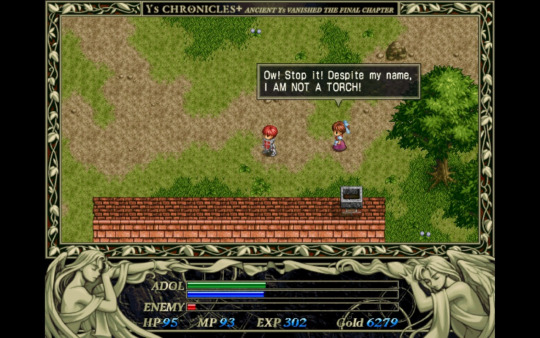
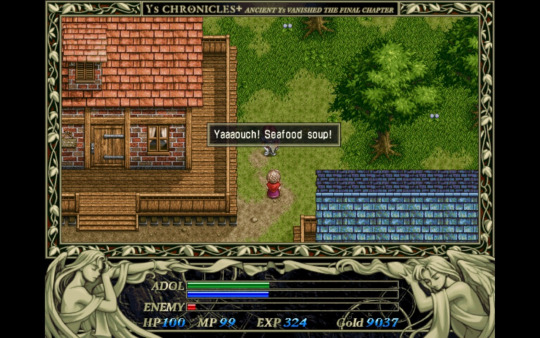
Otherwise, the game is more fleshed out, with a lot more places to go to. You’ve got a shrine and a mine combined into one general dungeon, a beautiful ice wall, volcanic caverns, and finally, the Shrine of Solomon. Compared to Darm Tower, the Shrine of Solomon isn’t quite as dominating, but it’s still huge, and sadly still requires a lot of backtracking. I’d wager it’s about a fourth of the game in of itself, possibly a third if you’re quick enough with the rest, and can still get pretty draining. Still, it’s a lot more enjoyable than Darm Tower, having more interesting environments, such as plenty of outdoor areas and a subterranean canal, and certainly lives up to the hype itself had built up. There’s no overworld, but considering how you were gated off by anything you weren’t a high enough level to take on in Ys 1, combined with how tiny and featureless said overworld was regardless, this linearity is preferable, giving a nice sense of progression. There’s also 4 towns spread out quite nicely, giving some much needed breathers after some of the more expansive parts of the game. The game is a decent bit longer than Ys 1, especially if you allow yourself to goof off and take in all the detail, like I did. Overall, Ys 2 has some much improved gameplay, and is a lot more fun than the already enjoyable first game.
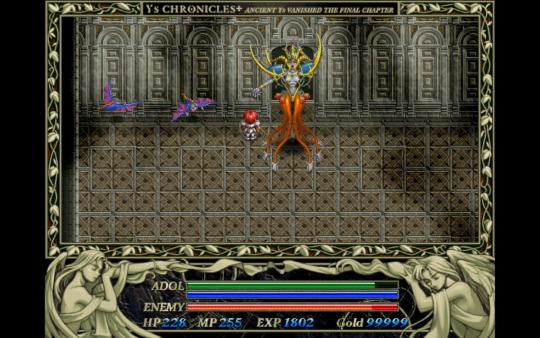
Graphics:
The graphics of Ys 2 are about the same level as Ys 1, namely, it looks great, especially the character artwork. One noticeable improvement comes in the area and enemy design, looking a lot more distinct than in the first game, making it all look a lot better. There’s also a dumb, but cute option that lets you hang a “mascot” on the screen, which just amounts to the sprites of various characters and enemies, more characters unlocking at maximum affection. Otherwise, I could just copy and paste I said in this section for the first game. Still, very good.
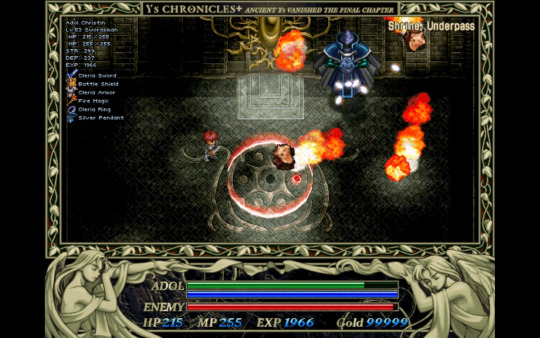
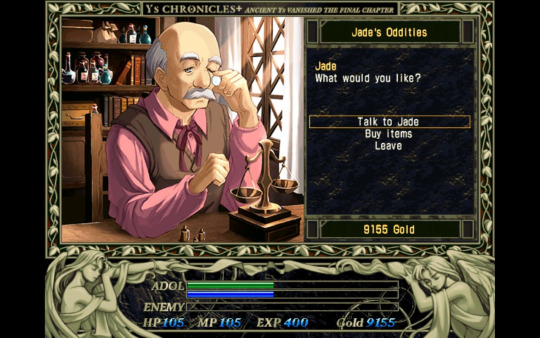
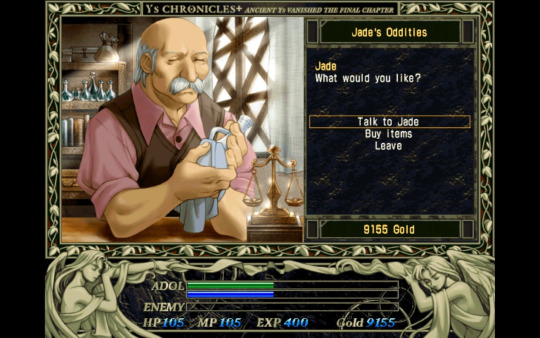
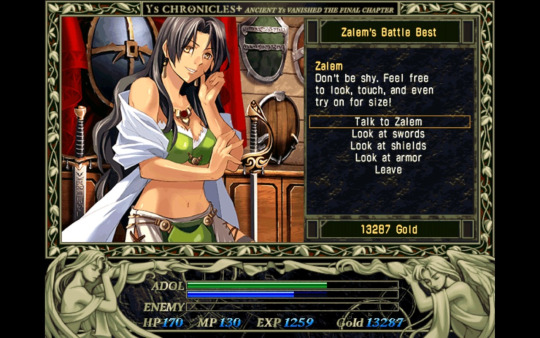
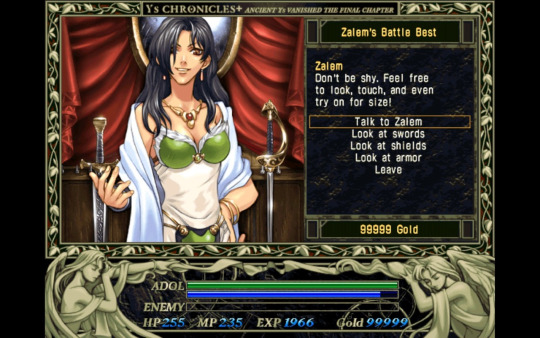
Sound:
The music, again, is very similar in quality to the first Ys, and is still amazing. Personally, I find the Complete remixes are a bit weaker compared to the first game, but the Chronicles soundtrack still hold strong. Some stand out pieces to me include Too Full of Love, Lance Village’s theme, Ruins of Moondoria, Ice Ridge of Noltia, Palace of Solomon, Tender People, Ramia Village’s theme, and this game’s remix of Feena, which is even better than the version in Ys 1. Overall, still a fantastic followup.
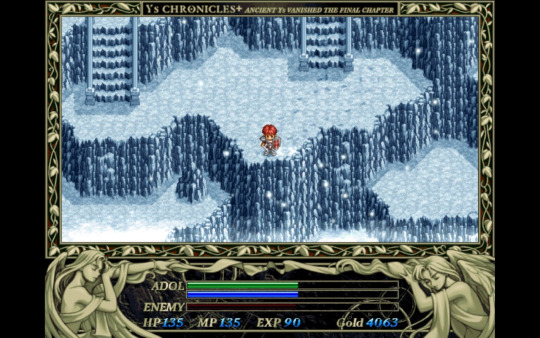
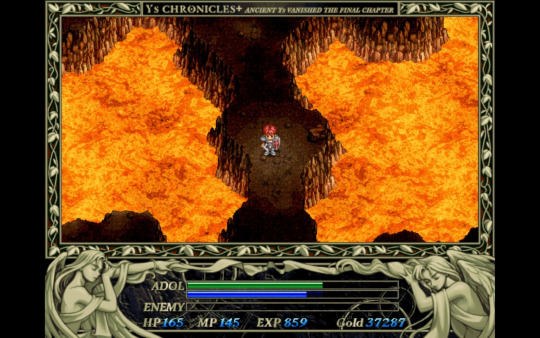
Conclusion:
Overall, Ys 1 & 2 Chronicles gets a recommended from me. It’s short length, questionable combat system, and overall signs of age can certainly be enough to make one wary, but getting past that leaves you with two games full of charm and passion. More than anything, they feel rather comfortable and relaxed. The shorter length, the various options for graphics and music, the general charm of it, and even the goofy and often context-less achievements, these two games manage to be memorable experiences.

This collection is a great introduction to one of the grandfathers of RPGs, a grandfather that’s still going strong after more than 30 years. Till next time, and apologies to anyone who reads this for how horrendously long this ended up.
-Scout
3 notes
·
View notes
Text
Curry watched anime: Summer 2018 edition
I guess I’m doing this now! I only really stuck to my Crunchyroll account, as I don’t have a HIDIVE or Amazon Prime sub, and Netflix doesn’t simulcast (I’ve been learning a lot of new terms over the last few months). I didn’t watch everything that was available to me either because I’m tired and etc you know me by now.
What’s that? You say I was supposed to be reading through old Marvel comics? You’re right, I fucked up. I’m juggling a lot of interests and I’m not the best at it.

I think the only show I watched that was on a non-first season was HeroAca and I’m not even done with it yet (and they immediately announced a 4th season, damn). Still, I’m 12 episodes in and it’s pretty good. Haven’t hit the absurd emotional highs of the first two seasons yet, but there’s time.

I watched the 12 available episodes of Angels of Death, and it looks like they’re gonna do an OVA for the last four episodes. I got in on this late due to low energy but I was intrigued because it’s an adaptation of those RPGMaker horror indie titles that Youtubers get famous off of. That’s almost deliberately aiming for my attention. This show is kinda dumb. Not because it’s edgy, I actually kind of enjoy that somewhat immature aspect, but because every time it decides to delve into western religion (which is a big theme, and all the characters are implied to be either American or English) it gets a bit confusing. I’m not sure if it’s subs being written with limited information (which it shouldn’t be, the game is out in multiple languages), or if the author just has a misinformed idea of how people talk about their faith. Rachel, a fourteen-year-old, talks constantly about her relationship with God, but specifically only in the context of what form of suicide is Breaking The Rules. It’s...interesting, but oddly so, and the episodes that revolve around a villainous priest and a witch trial are so vague and nebulously defined that I had no clue what any of the characters were talking about at any time. It’s also very clear they are staying true to the structure of the game, because there are many segments that feel like they lose their tension (or maybe their logic) when taken out of an interactive context. Anyway, I want to watch those last four episodes so I can form a full perspective, but I suspect that any upcoming twist won’t save what’s been established.

Cells at Work is really fun and I enjoyed the full 13 episodes, though I still find its overwhelming popularity surprising. There are shades of narrative, and plenty of implied worldbuilding (which is often my favorite kind), but this is mostly a series of notebook scribbles of someone’s OCs based entirely on making a comedic metaphor. It makes sure to stay this way, and all drama ultimately can’t last in the face of the the theme of “biology is funny.” On Reddit somewhere, a medical student was going through the show and pointing out all the surprisingly subtle details, like the Red Blood Cell with no sense of direction having a cowlick that represents sickle cells which have more trouble getting through the blood stream. Very clever stuff.

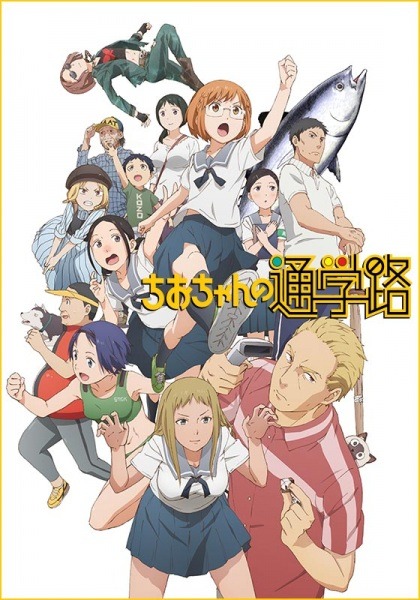
Asobi Asobase and Chio’s School Road are both hilarious and great comedic timing, but I still haven’t finished the latter. The former is about shitty schoolgirls who want an excuse to goof off, and the latter is about...mostly the same concept, but the main girl is a hardcore PC gamer who tries to solve IRL problems with her l33t skills. You have to take both with a grain of salt at times, especially if you’re LGBT. Asobase has some sketchy commentary on trans people, School Road’s lesbian is a pervert, and the shows overall swing with reckless abandon into lewd territory (imo said lewdness is often hilarious but ymmv). I think the main difference for me is that while I find both really entertaining, I’m actually growing fond of the characters in School Road? Meanwhile Asobase is an “Always Sunny” style comedy in that the characters are terrible and you should not imitate them (and also like Sunny you are occasionally made to wonder how self-aware the writers are).
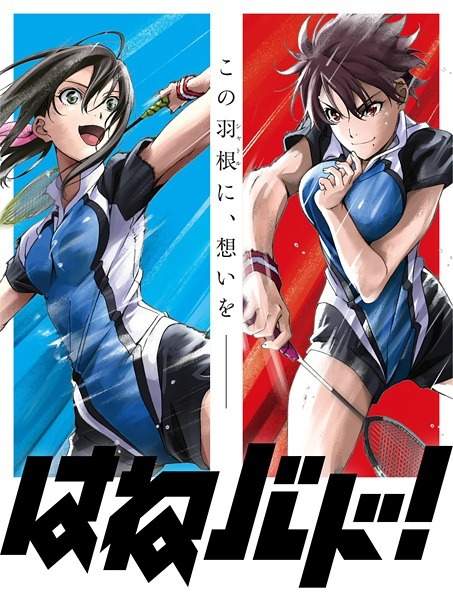
Hanebado is about the most traumatic sport in the world: badminton. Or so you’d think, considering that this show turned the drama faucet on full-blast and then cracked the dial off at the start of the season. It’s extremely good sports drama, and really nicely animated, but there’s a subplot of Extremely Bad Parenting that did not reach an appropriate resolution, or at least wasn’t communicated properly to the viewer, and I saw a lot of people reasonably pissed off about it.
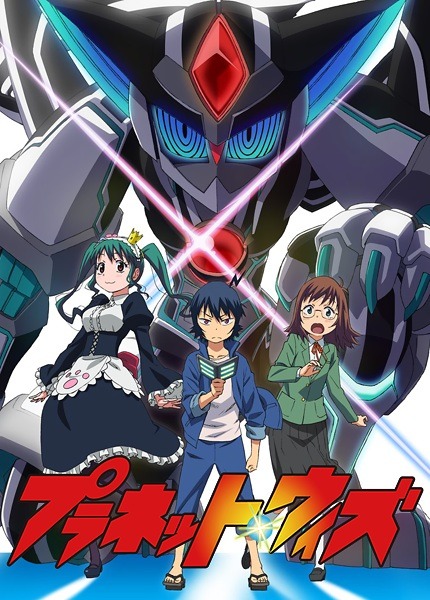
Planet With was probably the show of the season for me, and was even the reason I got a Crunchy premium account. A (kigurumi) mecha show with shades of Gurren Lagann that hits every shonen trope you can expect (well, except for a tournament arc) and subverts it with nuanced maturity, which is what I came to expect from Satoshi Mizukami’s writing. After reading Spirit Circle, I’m convinced everything he writes is gold. Not enough people watched this show, and it’s a shame, because the nuanced take on the difference between justice and compassion is pretty relevant today. I’m currently rewatching this with my sister and hoping I’ll pick up more than I did the first time through. I expect to watch it a third time in the future.
Show of the Season: Planet With Runner up: Probably Hanebado
Shows I also watched that weren’t from this season: - Ushio & Tora (wasn’t really worth the dedication, unfortunately) - KADO: The Right Answer (Fantastic until the last couple episodes collapsed in on themselves) - Digimon Tri movies 1 & 2 (this is gonna be rough)
Shows I dropped: - Angolmois (it’s not a bad show but I didn’t have the energy)
Shows I missed but still wanna watch: - Overlord S3 (haven’t started this show) - Banana Fish (wanna read this first (also no Prime ;_;)) - FLCL S3? (haven’t watched any of the new stuff yet) - High Score Girl (COME ON NETFLIX) - Revue Starlight (it’s on HIDIVE) - Kakuriyo: Bed & Breakfast for Spirits
Shows I missed and don’t know what to think about: - Grand Blue - Happy Sugar Life - Island - Harukana Receive
7 notes
·
View notes
Text
Forza Horizon Best Game
H8ded6oi Modes
The Kinect motion sensor has sold in excess of a thousands units inside leading 10 era with it's launch, and so this no doubt online game designers end up being dash in order to include Kinect capacity to their upcoming game concepts. If charged with rolling our Support Rushmore competition online game , Burnout 3: Takedown, Forza Horizon 3, Excel, and Go beyond 2006: Shore 2 Coastline are the subjects I'd engrave right big rock and roll. Evidently, I've a personal preference representing extra arcade-like contesting practices, a such as in which carries onto the Playground Games-developed Forza Horizon 4 (starting in $59.99). The open-world racer remains the series' history regarding stable car or truck, gorgeous locations, as well as bizarre head-to-head concern. That chapter, even so, adds vibrant, world-impacting seasonal result, deeper multiplayer integration, then a brand new progression practice that will enables a person tackle Forza Horizon 4's obstacle since you realize in shape. Many of the fresh on-line characteristics aren't absolutely so buzzing as the rest of the package, yet Forza Horizon 4 is a stellar contest video game, the one which represents decades involving clever gameplay improvements.
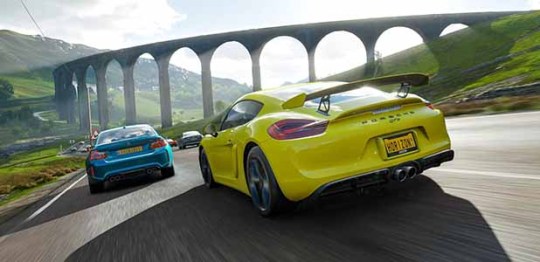
Due to the fact we're hsv then we can. Is the hsv gtsr w1 maloo ute safe and sound? Hsv developed the best aussie 4 door. The hsv gtsr w1 corresponds to a sincere endeavor Forza Horizon 4 PC Download to help transform the humble holden commodore to the greatest probable show car. Hsv in fact built several 'secret' gtsr maloo w1 products.
Cool off the exhibit floorboards on e3 2018 recreation space activities possesses exposed the forza horizon 4 guide sizing will be about the same dimensions such as australia inside forza horizon 3 rocket chainsaw. Forza horizon 4 will introduction by oct second along with the download sizing with hard drive room needed for it's been now confirmed through the official microsoft shop. Competition stunt make then check out decide on your own personal route to turn into a horizon superstar.
To be correctly sincere, the undeniable fact that Giuseppe Verdi's La Forza del Destino becomes cursed occurs other on account of cultural superstition than concrete results. The call translates on the Power connected with Providence after that the item can be an emotional melodrama concerning the function due to the curse place on Leonora before her kick the bucket minister. The imagined curse inside really Forza Horizon 4 Download lifetime experiences merely lots of people alarmed simply by Italians. By way of example, Pavarotti by no means play the meaning function in this opera, despite singing practically some other part within the Italian language repertoire. The one event attached with La Forza del Destino in which pilots anyone to speculate if there may be in fact a problem is due to U . s . baritone Leonard Warren.
Stadia unfortunately just isn't among the cover picks in this article not really single due to its meager activity selection and also on account of implementation difficulties. As a substitute, we notice several benefit of which cooperation a hefty collection of online game, offer you essentially good performance Forza Horizon 4 Full Download and also extended effectively with combined set of traits to be able to trunk. We are about to embrace the basics of every service as well as We've tied awake almost all providers down down below and so make sure to test them out after you live completed examining the article.
The future Massive Part of Forza Horizon 4 Computer Download
The most crucial thing in my opinion them to completely needed to strengthen by stayed the D-Pad. The directional sleep pad for the Xbox 360 became impassive, clunky and just a jam. About the Xbox One's report, How to Download Forza Horizon 4 it's sleek (with a good road), ahead and it assembles a wonderful press whenever you join demands around the pad. I'm inquisitive to see how well a scrap competition will certainly join in with this particular fresh controller.
The idea enormously performs perform nicely exceptional throughout each with every softwares : Xbox Just one next PC. Obtain How to Download Forza Horizon 4 Key Creator suitable missing along with buy in this great on the internet sport. Virtually a person who precisely would want to do with out the need to wage the new program code for your, our sort presenting opportunity to locate game basically regarding cost-free. Forza Horizon 4 Keygen can simply produce unending quantity associated with Cd-keys. You may need to do a tiny variety of basic moves. By utilizing totally free critical it truly is simple motivate online game and am involved in online at servers.
That is a multiplayer on-line game that occurs normally imagination stood anywhere people synergy with persons fro all over the world then embark on missions then fix unions very same Forza Horizon 4 Full Download for you to Quake Groups. A great deal of these tough you've got to "give to help engage in" on-line. Thus a person gave a regular subscription price only to participate in on the net every calendar month.
You could characterise it to be a very careful nevertheless talk changing associated with fat collected from one of ft . to a new; an identical, if much less dramatic, turn to the next produced by Gran Turismo with final being GT Sports activity. The default talk about of the before diversion became to be able to populate ones record with 'Drivatar' AIs, according to your own friends' reports. Forza Horizon 4 Download's default would be to be connected you in what the item name a 'Horizon Life' session, populating ones chart with many various other living gamblers. The last games' target was with a sprawling traditional job manner including several designed titles. Throughout Forza Horizon 4, the career's simply off-line module is removed backside in addition to harshly lacking throughout curation - that not very much a lot more than a steadily uncovering trail number - while one of the most appealing along with challenging functions happen time-limited contests to stay transferred into once a week updates, with Thurs night, as well as a coins involving year for many players. One of these simple structural moves is quite a bit far more prosperous versus new.
0 notes